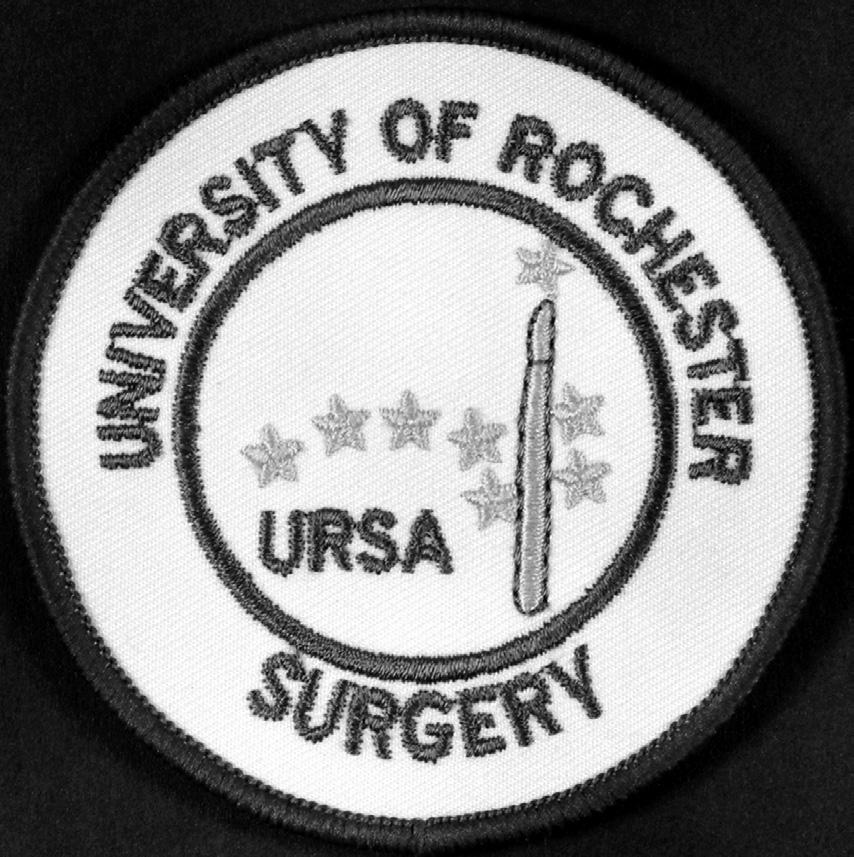




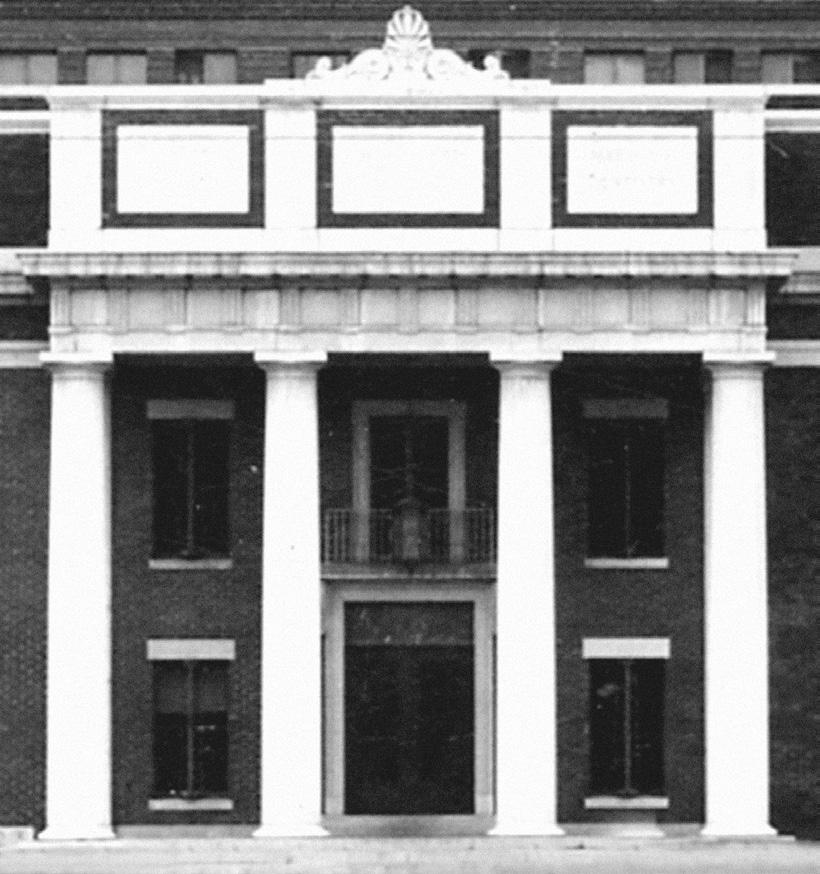
A HISTORY OF THE DEPARTMENT OF SURGERY
UNIVERSITY OF ROCHESTER 2019
Inside cover: Department logo (Big Dipper-Ursa* Major with scalpel pointed to Pole Star).
*Univeristy of Rochester Surgical Associates
The genesis of the Department of Surgery of the University of Rochester Medical Center was a direct consequence of the Flexner Report of 1910 that assessed the status of medical education in the United States of America. During its eight decades of existence, the department has been recognized by the unusually large number of academic leaders, who emanated from its ranks. The University of Rochester, when measured against older institutions, has provided an academic setting in which students, residents, fellows, and junior faculty progressed in their development to become academic leaders, with a major impact on national and international surgery.
It can be argued that other surgery departments have contributed more significantly to the science of surgery or have been more visible in their clinical accomplishments, but few have equaled the Department of Surgery at the University of Rochester Medical Center as an environment for the development of surgical leadership.
The history of the Department of Surgery and the surgical specialty divisions, which have been integral elements of the department, recounts a continuous evolution. The history presents cogent evidence of the department’s contribution to the dissemination of surgical education by nurturing surgical leaders through rigorous academic and clinical training, and the consequent production of an impressive array of chairs of surgery departments, heads or chiefs of surgical specialty departments and divisions, leaders of medical institutions and distinguished surgical societies, not only within this country but also around the world. The history of the Department of Surgery of the University of Rochester Medical Center, with its extraordinary performance, is offered as a stimulus for engendering and perpetuating pride in those who have been and will be associated with the University of Rochester Medical Center.
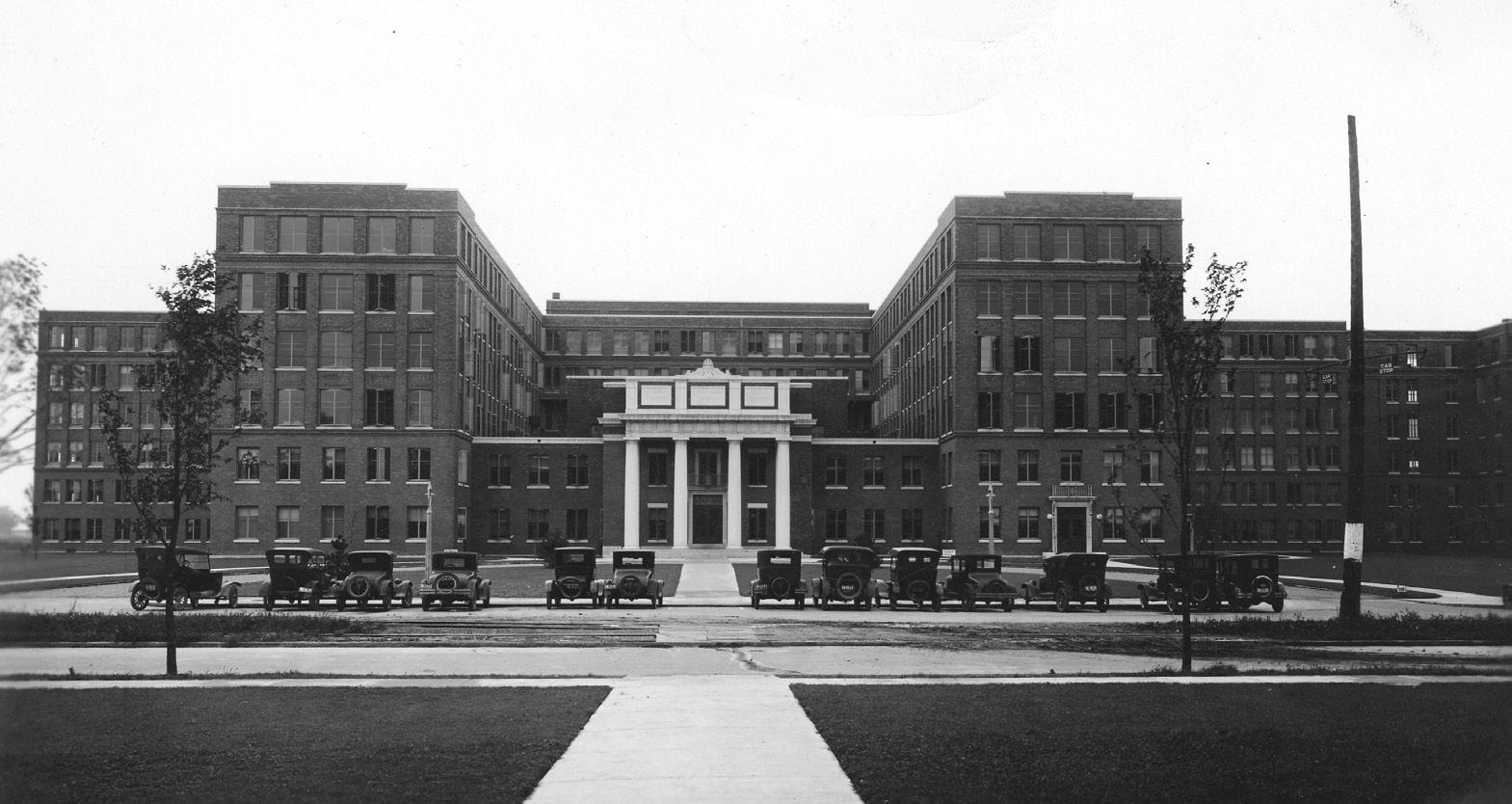
The portals of the Department of Surgery, through which people entered and from which people and projects emanated, are integral parts of the structure of the University of Rochester Medical Center. As such, the department’s genesis, evolution, and educational philosophy, constitute a reflection of institutional attitudes that have persisted for more than eight decades.
The conception of the University of Rochester Medical Center can be traced specifically to the 1910 report of Abraham Flexner, conducted under the auspices of the Carnegie Foundation for the Advancement of Teaching. This revelatory and explosive report spelled the death knell for a bevy of marginal medical schools, including all but one or two independent institutions, and led to the integration of medical education under university control.
As a continuum of the report, Flexner was charged with the responsibility of creating new medical schools within established universities. The plans were to support about a half dozen new or reorganized schools, aided by resources from the Rockefeller Foundation, including one in New York State. Flexner, who held University of Rochester President Dr. Rush Rhees in great esteem, convinced Dr. Rhees that the University of Rochester could be the locus for a new medical school. George Eastman, who had provided the university with funds to develop a school of music, agreed to a personal gift of $4 million and committed himself to raise an additional $1 million, provided the cumulative amount was matched by a gift from the General Education Board of the Rockefeller Foundation. The Rockefeller Foundation agreed, and the two gifts were announced by Dr. Rhees at the university’s commencement on June 11, 1920.
The sites selected for the university, the medical school and the hospital were located at the southern edge of the City of Rochester, where the Genesee River bends toward the city center. At the time, the land, consisting of 82 acres, contained the golf course of the Oak Hill Country Club, which Oak Hill agreed to sell to the university for relocation of the Men’s College, then on Prince Street. The Women’s College remained, temporarily, at the Prince Street location, while Oak Hill moved to its current location in Pittsford. An additional 97 contiguous acres of farm and nursery land were reserved for construction of the medical school and hospital.
George Hoyt Whipple, recruited from the University of California, San Francisco, became the first dean of the University of Rochester School of
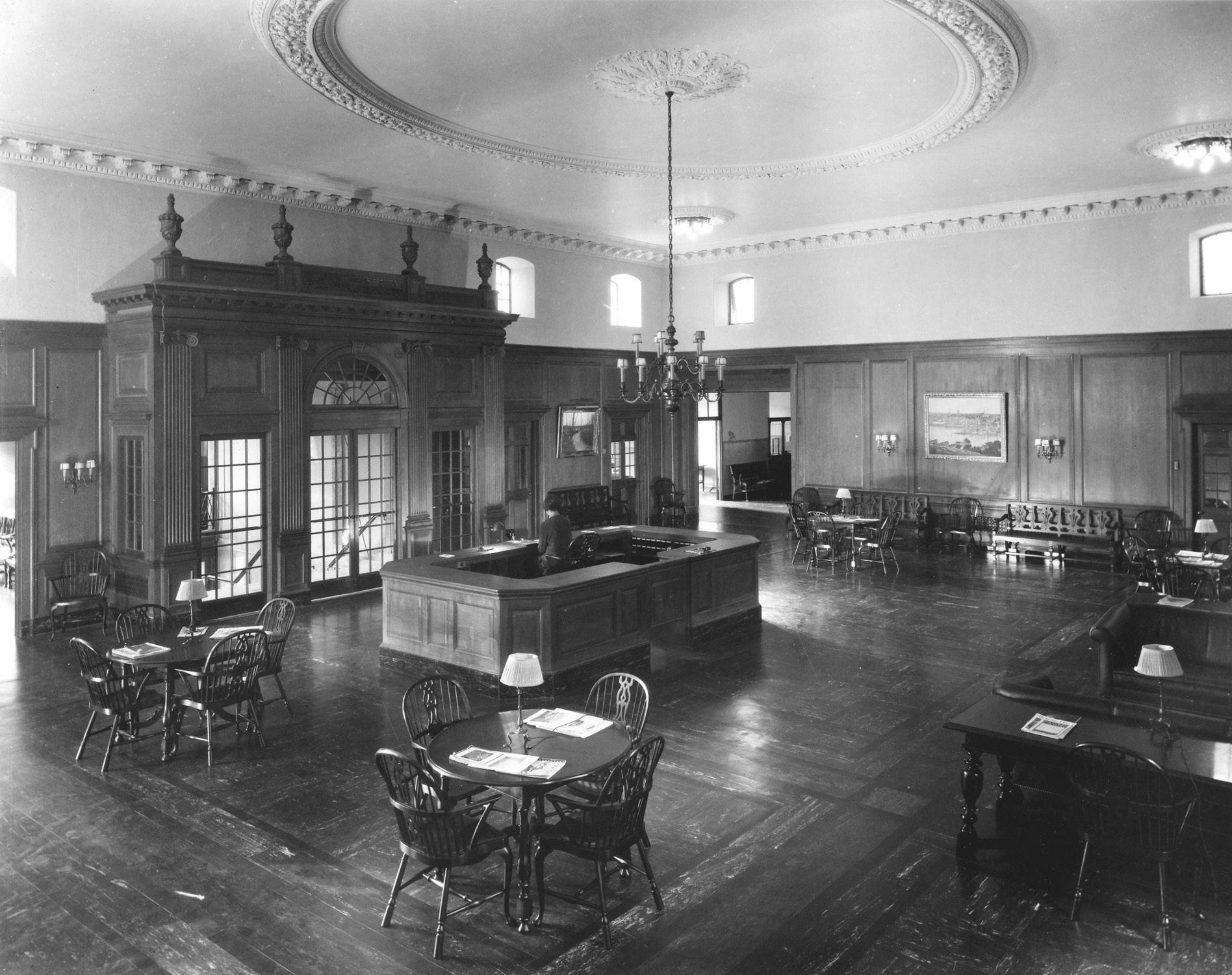
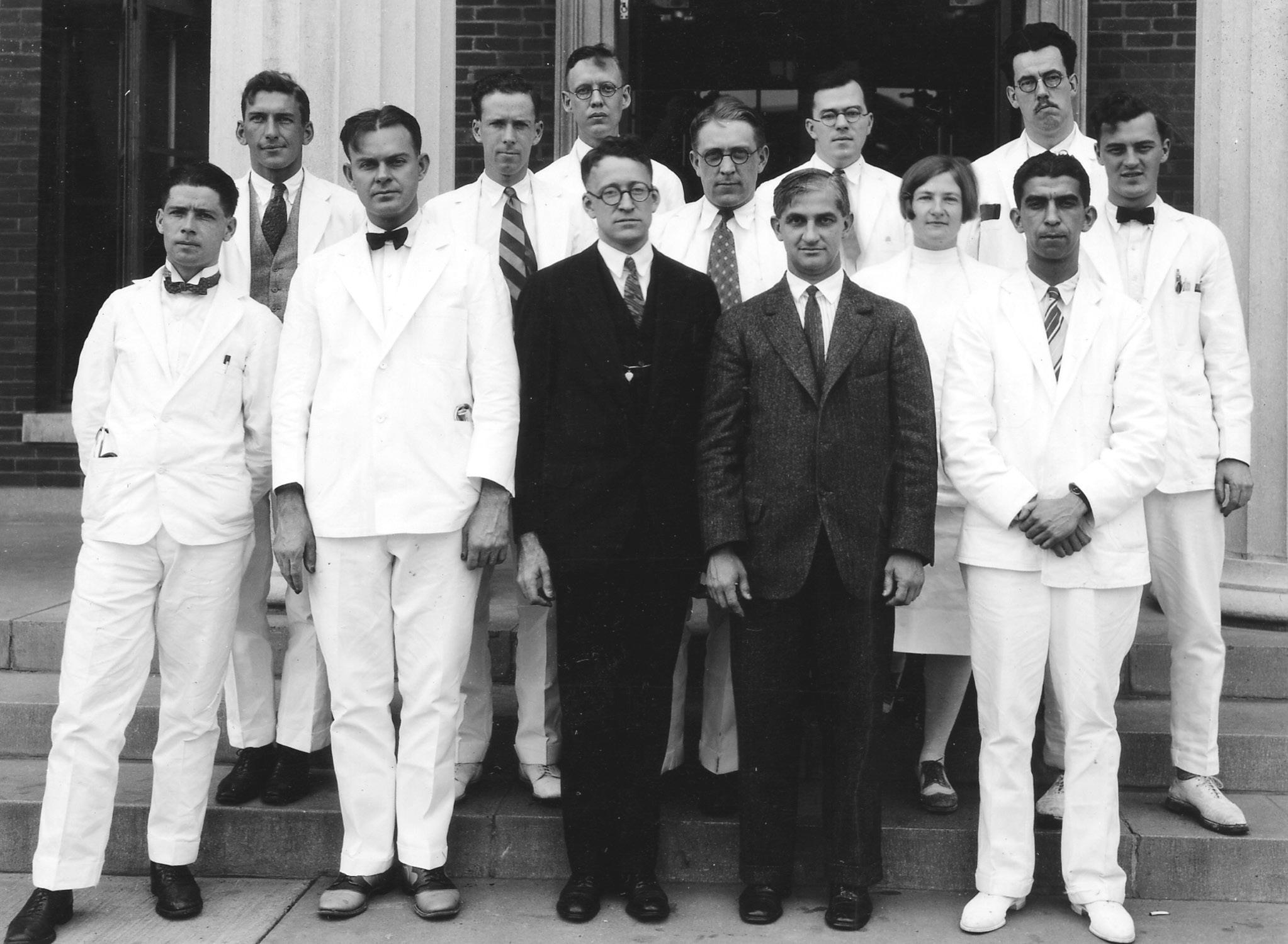
Medicine and Dentistry in September 1921. Whipple would later share the Nobel Prize for Physiology and Medicine with George Richards Minot and William Parry Murphy in 1934 “in recognition of their discoveries respecting liver therapy in anaemias.”
Whipple’s initial appointment was Nathaniel W. Faxon as director of the proposed Strong Memorial Hospital, named for Henry Alvah Strong, George Eastman’s first partner in Kodak, and Helen Griffen Strong. Subsequently, George W. Corner was named as professor of anatomy, sequentially followed by: Walter R. Bloor, professor of biochemistry; William S. McCann, professor of medicine; Karl M. Wilson, professor of obstetrics and gynecology; John J. Morton, Jr., professor of surgery; Samuel W. Clausen, professor of pediatrics; and Wallace O. Fenn, professor of physiology.
In the fall of 1925, the first medical school class, consisting of 20 male and 2 female students, matriculated, and, in 1926, Strong Memorial Hospital opened as a 250 bed hospital incorporating the Rochester Municipal Hospital. The hospital formally opened its doors on January 4, 1926. Dr. Morton performed the first operation, a resection of a mixed tumor of the parotid on January 7. Coincidentally, one of the first operations performed in the oldest extant operating room of the oldest hospital in the United States, the Pennsylvania Hospital, was also a resection of a mixed tumor of the parotid.
John J. Morton Jr., a Massachusetts born graduate of Amherst College and Johns Hopkins Medical School, served as the world renowned Dr. Harvey Cushing’s second intern at Peter Bent Brigham Hospital. He then spent two years in internal medicine at the Rockefeller Institute Hospital before completing his surgical training at the Massachusetts General Hospital. He practiced orthopaedic surgery in New Haven for a short period of time and then joined the Yale faculty as associate professor of surgery under Dr. Samuel Harvey. Dr. Morton accepted the position as professor of surgery at Rochester in May 1923 and arrived a year later. Dr. Morton, an international authority on bone tumors, performed the first hemipelvectomy in the United States at Strong Memorial Hospital.
Dr. Morton devoted the first year of his activities in Rochester to overseeing outpatient facilities, the emergency ward, and operating rooms. This included lighting, sterilizers, anesthesia machines, furniture and instruments; as he stated “everything from safety pins to operating tables.” Provision was made for the production of splints and a variety of apparatuses for physiotherapy and radiotherapy. He also directed his attention toward assembling “a teaching staff, experimental laboratories, and integration of surgery with pathology, bacteriology roentgenology, anatomy, physiology, and biochemistry.”
By the time Strong Memorial Hospital opened, Dr. W. J. Merle Scott had arrived from Lakeside Hospital in Cleveland to serve as assistant professor of surgery. Dr. T. Banford Jones became the first surgical resident, and Dr. Samuel
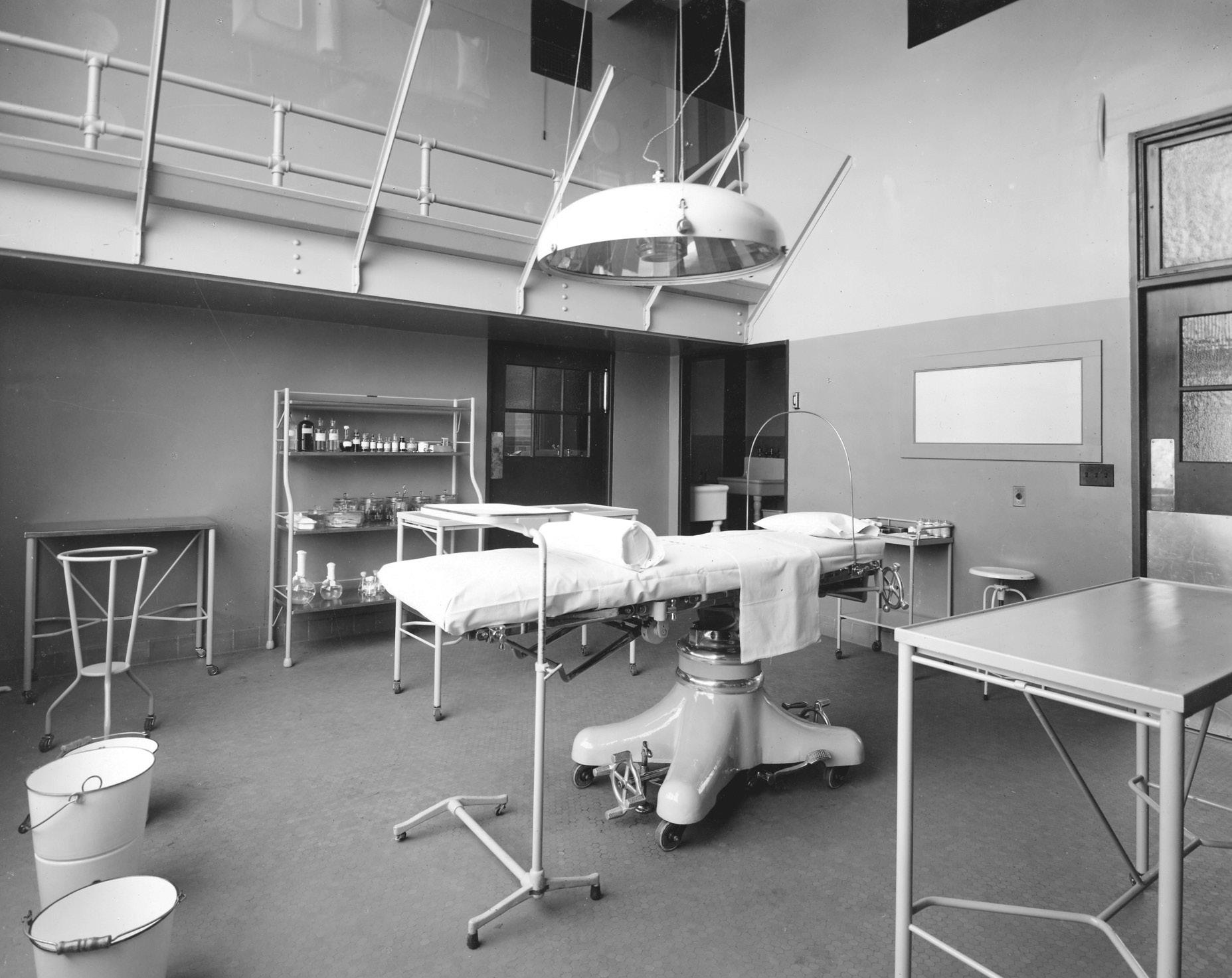
Fifth Floor Operating Room, 1926 (Note viewing balcony).
C. Roth, a graduate of Washington University, St. Louis, arrived as the first surgical intern. Dr. David M. Davis, already in practice in Rochester, was appointed assistant professor of urology, a position he held until the appointment of Dr. W. W. Scott in 1929.
In July 1926, Dr. Samuel J. Stabins assumed the role of the first assistant resident in charge of the experimental surgical laboratory. Dr Stabins eventually became chief of surgery at The Genesee Hospital and the first president of the Society of University Surgeons. Also, in 1926, Dr. R. Plato Schwartz was recruited to head the section of orthopaedics, and Dr. Clyde Heatly arrived to organize teaching and research in oto-rhino-laryngology. A tumor clinic, under the auspices of the Department of Surgery, one of the first to be organized in a general hospital, was initiated.
The formal dedication of the School of Medicine and Dentistry and Strong Memorial Hospital took place on October 25 and 26, 1926. As part of the program, Dr. Harvey Cushing, presided at the first surgical clinic in Strong Memorial Hospital, discussing the treatment of pituitary tumors.
In 1927, Dr Herman E. Pearse joined the residency staff as a Rockefeller Fellow. Dr. William Van Wagenen became a member of the surgical staff in 1928, and, in 1930, was designated assistant professor of neurological surgery. The Department of Surgery created a subdivision of plastic surgery under the direction of Dr. Forest Young in 1934. By the end of that decade, the department recorded 35,000 surgical procedures and averaged 400 operations per month. The major specialties of urology, orthopaedics, neurosurgery, oto-rhino-laryngology, plastic surgery, and dental and oral surgery were well established subdivisions of the department. A co-operative internship with obstetrics and gynecology was created.
Dr. Morton continued as chair until 1953. During his tenure the general surgical staff included: Dr. Earle B. Mahoney, who joined the faculty in 1939; Dr. John A. Schilling, who was appointed instructor in 1944; Dr. George L. Emerson, who had trained in the department and returned in 1946 after a fellowship in thoracic surgery at Yale Medical Center; and Drs. Charles D. Sherman, Harry D. Kingsley, Michael Radakovich (Rains), and W. Andrew Dale, all of whom completed their surgical residencies at the University of Rochester.
Dr. Morton also forged educational affiliations with The Genesee Hospital, Bradford Hospital in Pennsylvania, Tompkins County Memorial Hospital in Ithaca, Clifton Springs Sanitarium and Iola Sanitarium. A residency in plastic surgery was initiated after the war, as well as a rotation in orthopaedic surgery at Rochester General Hospital.
The department hosted the inaugural meeting of the Society of University Surgeons in 1939 and two meetings of the Society of Clinical Surgery during the 26 years of Dr. Morton’s term. During Dr. Morton’s tenure, research interests of the
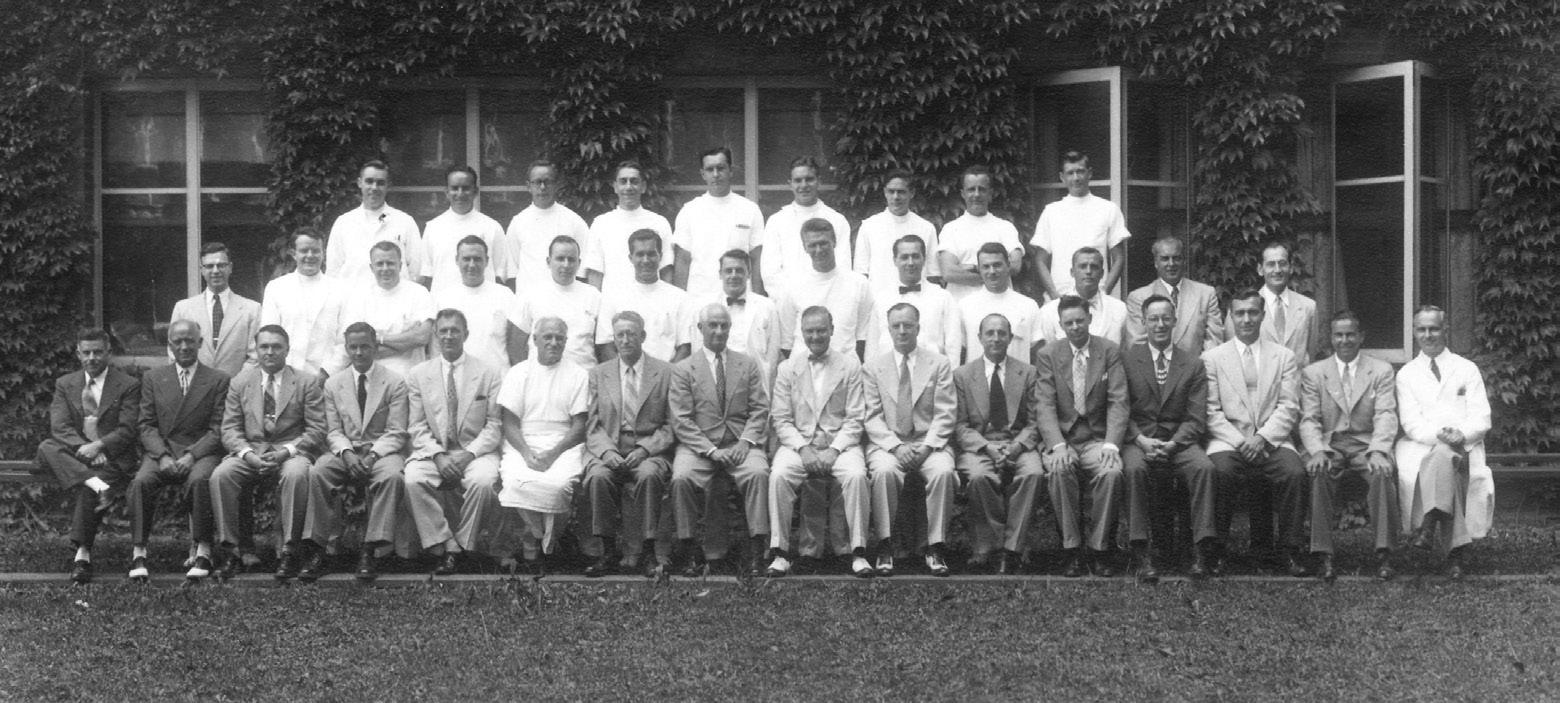
Surgical Faculty and Resident Staff, 1951.
department included: experimental cancer research; bone tumors; the sympathetic nervous system related to vascular disease and hypertension; atelectasis; bile duct reconstruction; large vessel occlusion; burns; shock and fluid replacement; liver function and ascites; gait recording; scoliosis; submicroscopic structure of bone; bladder tumors; prostatic hypertrophy; congenital abnormalities of the urinary tract; renal circulation and diuresis; diabetes insipidus; epilepsy; prefrontal lobotomy; intraocular transplantation of tumor tissue; esophagoscopy and bronchoscopy, including the development of instrumentation.
Dr. W. J. Merle Scott became chair of the Department of Surgery in 1955 after two years as pro tempore chair, and served for five years. During this period, Dr. Frank P. Smith was appointed chief of the Division of Neurosurgery, and four of the general surgical residents who completed the program joined the faculty, beginning with John H. Morton (1954), J. Raymond Hinshaw (1955), James A. DeWeese (1956), and Seymour I. Schwartz (1957). In 1959, Dr. Schwartz organized the first annual Surgical Chief Residents’ Conference, which was hosted by the department. Residents from almost all major programs within the United States attended. The conference continued on an annual basis and, ultimately, was incorporated in the annual meeting of the Society of University Surgeons. In 1960, Dr. Schwartz became the first and only member of the faculty of the University of Rochester School of Medicine and Dentistry to receive the John and Mary Markle Scholarship in Academic Medicine.
The five years of Dr. Scott’s leadership was marked by a significant escalation of research and productivity. Dr. Dale, followed by Drs. DeWeese and Schwartz, coordinated the research laboratory. Projects led by Dr. Mahoney investigated cardiac surgery and the applicability of total body hypothermia. Drs. Dale and DeWeese focused on peripheral vascular surgery, including arterial reconstruction and phlebography. Dr. Schwartz examined the effects of electrical charge on thrombosis, In the nation’s first laboratory sponsored by the Atomic Energy Commission, Drs. Kingsley and Hinshaw studied burns and the role of topical zinc in healing.
Drs. Sherman, Mahoney, and Dale reported on the use of the right colon as replacement of the intrathoracic esophagus. Drs. Schwartz and Dale presented the first series of patients with primary sclerosing cholangitis, while Drs. Schwartz, George L. Emerson and Harold Bales reported the first series of cases of bleeding esophageal varices treated with intravenous pituitrin (vasopressin). Dr. Emerson reviewed histoplasmosis of the lung and the natural history of pulmonary carcinoma.
In the specialty divisions, Dr. Louis Goldstein continued his study of scoliosis; Dr. Sidney Lerner investigated glaucoma and associated biochemical abnormalities; Dr. Jorgen Schlegel studied the efficacy of intravenous fluids and low molecular weight dextran on renal function; and Dr. John A. Benjamin, in conjunction with Dr. James Sibley Watson, performed the first cineradiography of the urinary tract.
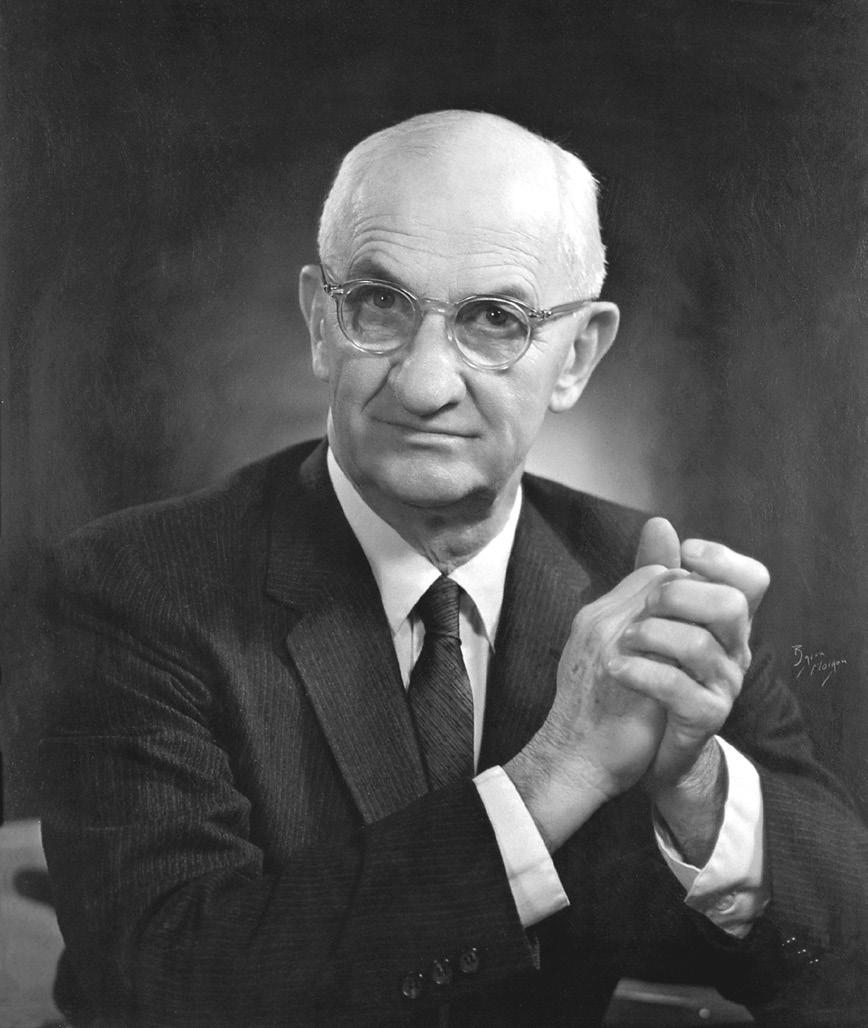
(1925-1952)
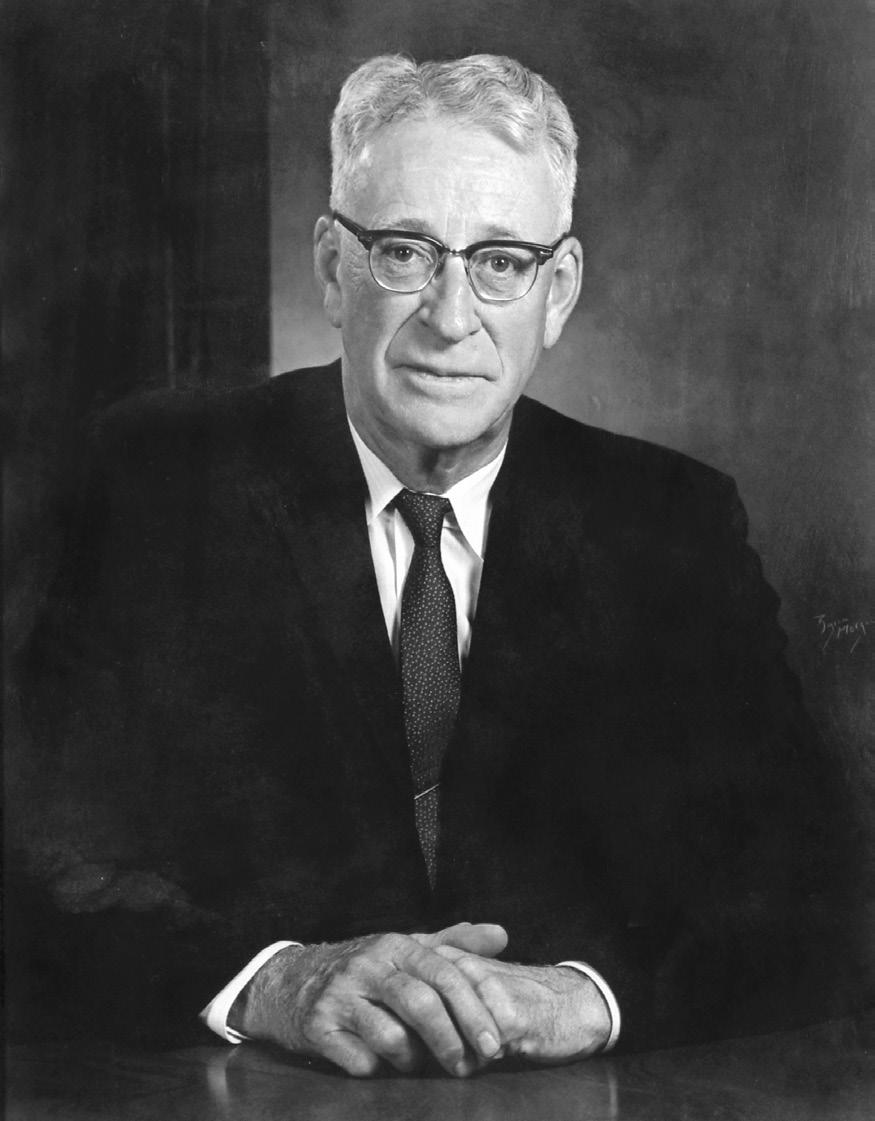
Dr. Charles Rob, a distinguished vascular surgeon and professor of surgery at St. Mary’s Hospital, London, began a 17-year period as chair of the department in 1960. Dr. Rob designated Dr. John H. Morton as coordinator of the internship program and James A. DeWeese as coordinator of the residency program. Dr. Seymour I. Schwartz was named director of surgical research. During the years of Dr. Rob’s leadership, Drs. Walter J. Pories and Allyn G. May joined the faculty on completion of their residencies and, in 1962, Dr. James T. Adams, the first graduate of an external residency, joined the faculty. In 1964, Dr. Joseph V. Mc Donald was appointed chief of the Division of Neurosurgery, and a year later, Dr. John Frazer became the first full time professor of the Division of Otolaryngology.
Dr. Rob was dedicated to amalgamating the residency program on a citywide basis. In 1967, Dr. René Menguy was appointed chief of surgery and director of the surgical residency program at The Genesee Hospital and Professor of Surgery at the University of Rochester School of Medicine and Dentistry. Dr. J. Raymond Hinshaw, Dr. Harry D. Kingsley, and Dr. Raymond Graziani, respectively, were designated with similar titles at Rochester General Hospital (1965), Highland Hospital(1967), and St. Mary’s Hospital (1968). Rotations were established at Batavia Veteran’s Administration Hospital, which specialized in tuberculosis, and at Willard State Hospital.
In 1968, the integration of the hospitals’ multiple residency training programs into a single University of Rochester Surgical Residency was formalized with two subsets. Interns (R1 residents) were appointed by each hospital and served their initial year at that institution. R2 and R3 residents were appointed by a committee of the chiefs of the services and rotated to two of the hospitals. The three residents at Strong Memorial Hospital spent one or two years in research positions before completing their fourth and fifth years, while the other residents completed their training at the institution where they had been initially accepted.
In 1969, anesthesiology became the first surgical division to be designated a separate department. In 1975, coincident with the appointment of Dr. C. McCollister Evarts as chief, orthopaedics became a department distinct from surgery. During the period of Dr. Rob’s chairmanship, the department’s national visibility in vascular surgery rose significantly, particularly because of seminal contributions by Drs. Rob and DeWeese. Drs. Adams and DeWeese made an important contribution to the treatment of venous thrombosis with the development of a clip to partially interrupt inferior venacaval flow and prevent pulmonary embolization. In the laboratory, Dr. DeWeese studied whole body hypothermia and its application to cardiac surgery and the issue of myocardial preservation. Dr. Pories and Dr. Hinshaw investigated the role of zinc in skin repair. Dr. Schwartz studied the application of hyperbaric oxygenation, the pathophysiology of ascites, the isotopic evaluation of portal circulation, the use of isotopically labeled antibodies to fibrinogen as a method of detecting thrombi, and platelet abnormalities associated with shock.
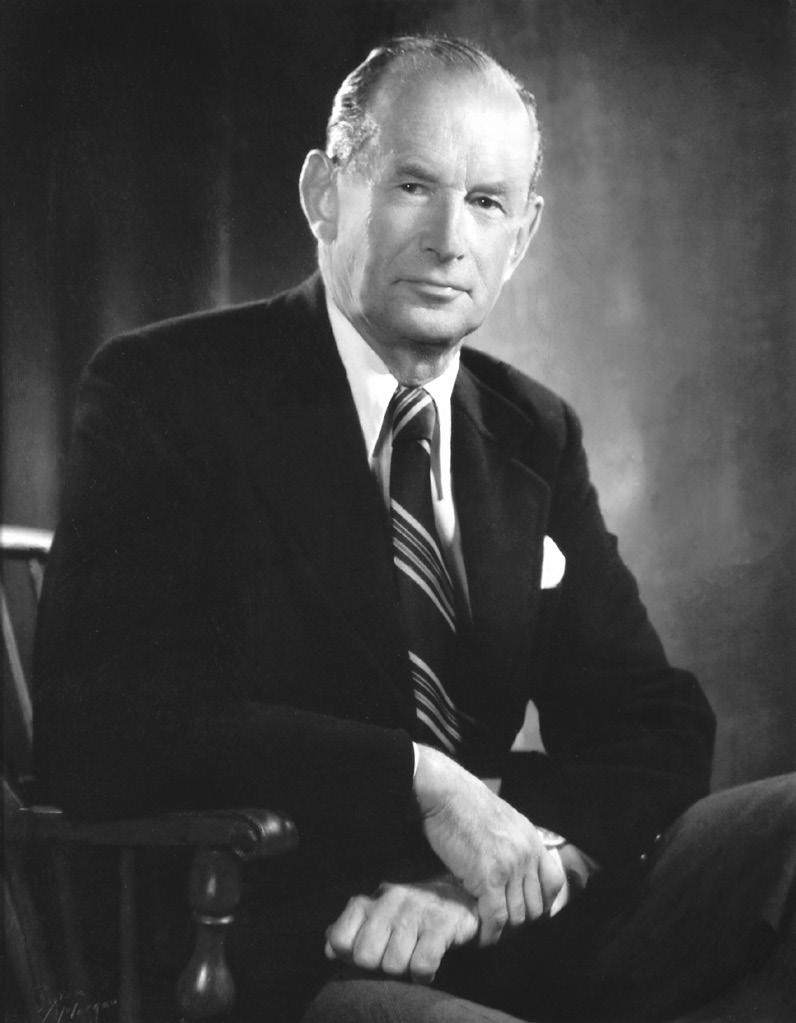
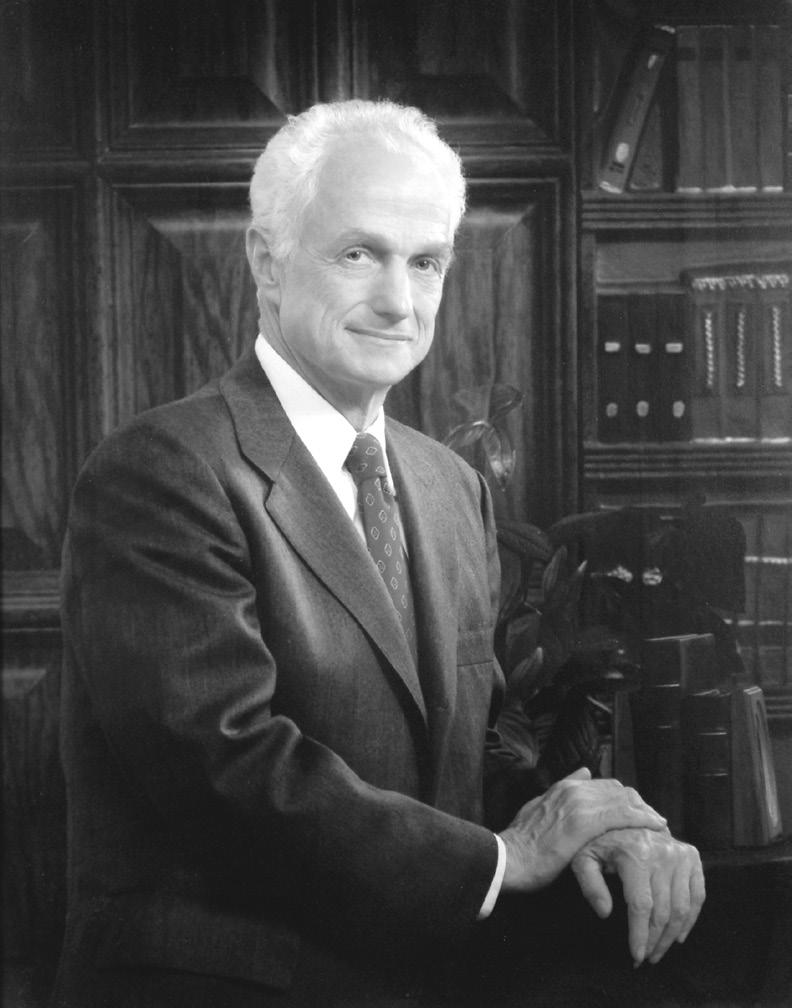
Dr. Schwartz and Lawrence Griffith, a third year medical student, reported the laboratory and clinical experience with the use of electrical stimulation of the carotid sinus nerve to control intractable essential hypertension. In 2005, Dr. Karl Illig rejuvenated the procedure by performing the first modern direct stimulation of the carotid sinus for hypertension in this country, leading to a national study that he would head. Drs. Sidney Lerner and Seymour Zigman published the result of several studies concerning the biochemical factors involved in the formation of cataracts. In urology, Dr. Donald McDonald investigated cryotherapy of bladder tumors, and Dr. El Badawi defined the innervation of the bladder musculature. The Division of Anesthesia, while still part of the Department of Surgery, evaluated autotransfusion and assessed anesthetic agents and their implication as a cause of hepatic dysfunction.
Dr. William R. Drucker assumed the chair in 1977 and served for ten years. He had been a surgical resident and faculty member at Case Western Reserve, chair of surgery at the University of Toronto, and dean of the University of Virginia Medical School. He recruited Dr. Paul R. Schloerb, a graduate of the University of Rochester School of Medicine and Dentistry, to direct the nutritional support service. A partially integrated residency program was developed that became a non-pyramidal [block] progression in 1979, with the dominant time spent at Strong Memorial Hospital coupled with rotations through Rochester General Hospital, The Genesee Hospital, Highland Hospital, and St. Mary’s Hospital. Six residents completed the program annually.
In 1975, cardiothoracic surgery was designated a division in surgery, and Dr. DeWeese was appointed as chair. In 1981, Dr. Arthur Hengerer succeeded Dr. Frazer as chair of the Division of Otolarygology. In 1984, Dr. R. Christie Wray was recruited as chair of the Division of Plastic Surgery. A section of vascular surgery, with Dr. DeWeese as chief, was established within general surgery in 1987. In 1991, he was replaced by Dr. Richard M. Green, and divisional status was assigned in 1998.
During Dr. Drucker’s tenure, the major research and clinical projects within the department included: protein depletion, total body water measurements, platelet aggregation and sequestration, neointimal fibrous hyperplasia, glucose defense during shock, cardioplegia, fluoroscein assessment of intestinal viability, myeloproliferative disorders and splenectomy for hematologic diseases, the use of a sulfamylon laminated dressing for burns, intra-arterial infusion of liver metastases using an implantable pump, and the effect of cytomegalic viral infection on renal graft survival.
Dr. Seymour I. Schwartz was appointed chair in 1987 and served for 11 years. In July 1989, Drs. David A. Krusch, James L.Peacock, and Harry C. Sax arrived as the first of the new faculty to be recruited under Dr. Schwartz’s leadership. Dr. Krusch initiated studies on isolated pancreas perfusion and trained Dr. Carolyn Jones, the department’s first PhD candidate. Dr. Krusch applied his computer
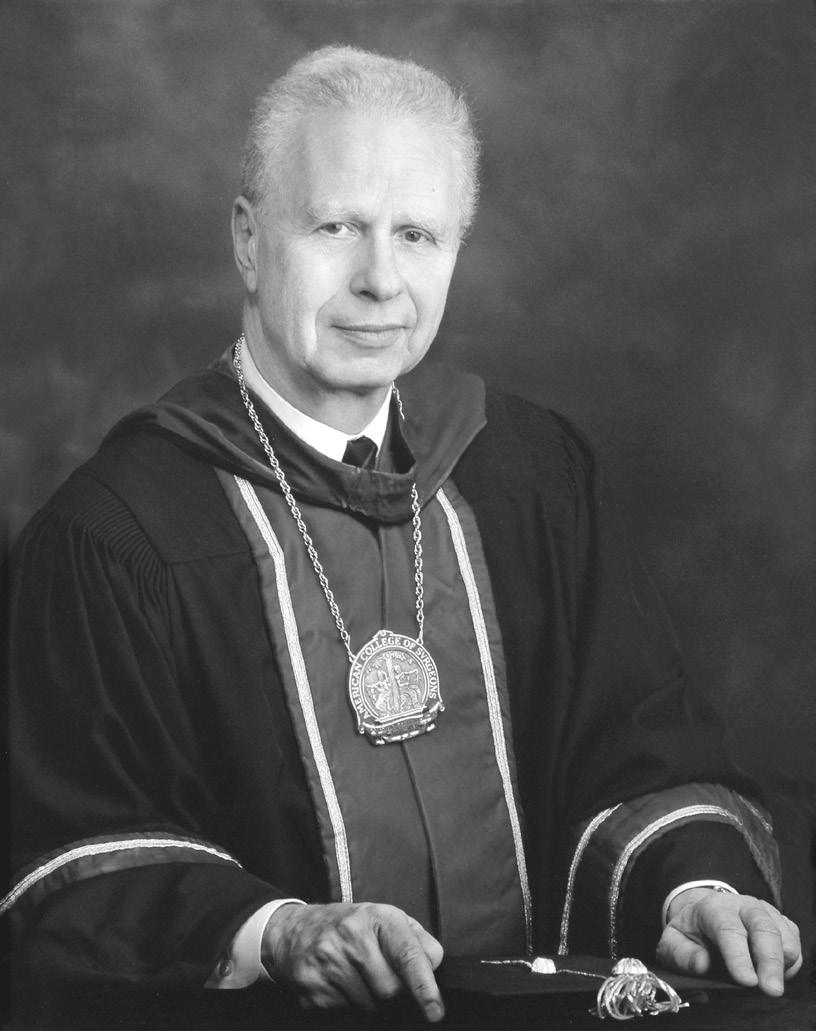
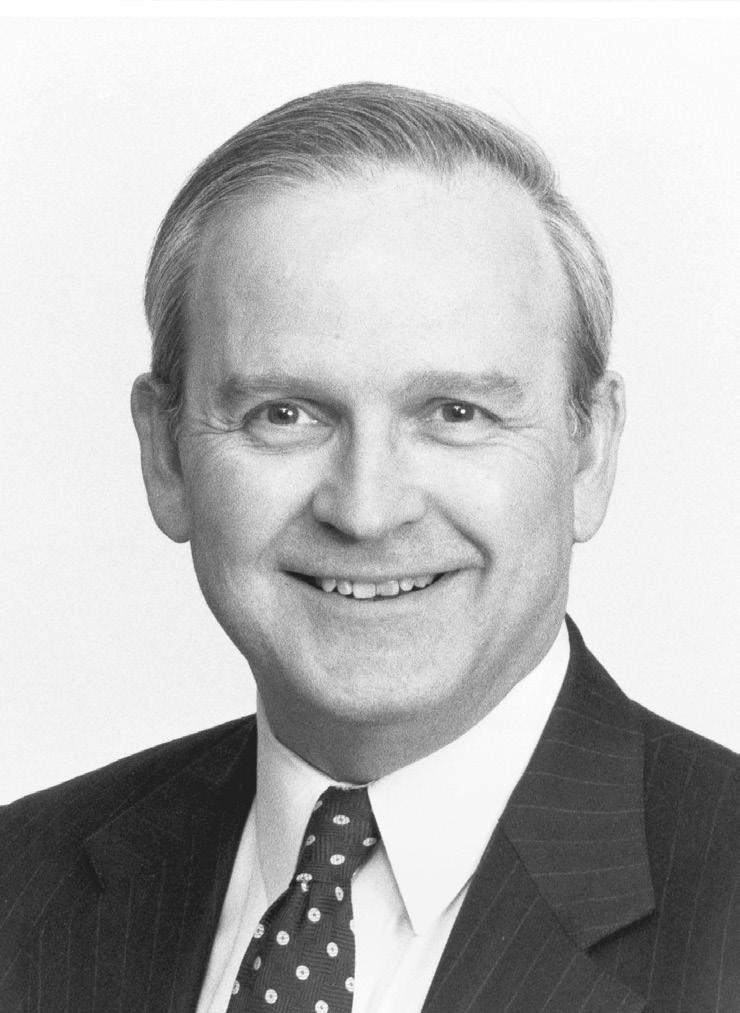
expertise to direct the Medical Center’s Informatics Division and chaired the American College of Surgeons newly established Informatics Committee. Dr. Peacock developed a laboratory to study tumor necrosis factor and cachexia, and, during Dr. Sitzmann’s tenure, became the surgical residency program director. Dr. Sax investigated intestinal transport of amino acids in his laboratory and directed the hospital’s Nutritional Support Services. In 2005, he accepted a position as chief of surgery at Miriam Hospital and professor of surgery at Brown University in Providence, Rhode Island.
Recruitment strengthened the sub-specialties of general surgery. Dr. David Feliciano established the section of trauma. He left after two years to become chief of surgery at Grady Hospital, Emory Medical Center. Dr. Palmer Q. Bessey replaced Dr. Feliciano, and rejuvenated the burn center before he moved to the burn center at New York Hospital.
Dr. James Cerilli successfully established a transplantation section. He was joined by Drs. Michael Morris and Mark Orloff. Dr. Oscar Bronsther replaced Dr. Cerilli, who retired, and established a team, including Dr. Luis Mieles, that performed liver, pancreas, and small intestinal transplantation. Dr. Walter Pegoli joined the faculty and initiated the section for pediatric surgery. The last of the general surgical recruits during this era was Dr. Luke Schoeniger, recipient of the Wilmot Fellowship for Cancer Research, who temporarily became the director of surgical oncology. In 1991, Dr. Eugene D. George, was appointed chief of the division of neurosurgery, and Dr. George L. Hicks Jr. was designated chair of cardiothoracic surgery.
At the time of his retirement from the chair in 1998, Dr. Schwartz was appointed Distinguished Alumni Professor of Surgery, and the surgical chair was endowed and named the Seymour I. Schwartz Chair of Surgery. Dr. Arthur Hengerer served as interim chair until Dr. James V. Sitzmann was recruited to the position in 1999. After training at Johns Hopkins Medical Center, Sitzmann rose to the rank of professor of surgery before assuming the chair of surgery at Georgetown Medical Center. Dr. Sitzmann’s tenure as chair of surgery at University of Rochester Medical Center was unfortunately abbreviated by a devastating bicycle accident in 2001, at which time Dr. Hengerer once again became interim chair.
During his brief tenure, Dr. Sitzmann recruited Dr. Paul Bankey, as head of trauma and critical care, and Carol Miller-Graziano, as director of surgical research. The trauma faculty was expanded with the additions of Dr. Julius Cheng, Dr. Mark Gestring, and Dr. Nicolle Stassen, as well as Dr. Christopher Lentz as director of the burn center. Dr. Amadeo Marcos was recruited to head transplantation. The hepatic transplantation program expanded exponentially, becoming the largest live-donor program in the world under his stewardship. Dr. Marcos added Dr. Adel Bozorgzadeh to the faculty; he assumed the directorship when Dr. Marcos left to direct the Pittsburgh program. Drs. Ashok M. Jain and Peter Abt were later added to the transplantation faculty. In general surgery,

Dr. Jeffrey Peters (2004-2014)
Dr. Steven Ahrendt was recruited as director of gastrointestinal oncology, while Dr. Gretchen Ahrendt became director of breast and endocrine surgery. Dr. Rabih Salloum also joined the faculty after completing his fellowship in surgical oncology. Dr. George T. Drugas and Dr. Mary Catherine Santos were added to the pediatric surgery faculty.
Dr. Jeffrey Peters, a professor of surgery at the University of Southern California noted for his leadership in the field of esophageal surgery, assumed the position of chair in July 2004 until September 2014. He restructured the department creating its current10 divisions:
Cardiac Surgery: George L. Hicks (chief), George M. Alfieris, James A. DeWeese, Peter A. Knight, H. Todd Massey
Colorectal Surgery: Samantha Hendren, Rabih Salloum, Seymour I. Schwartz
GI/ Bariatric Surgery: Joseph Johnson (chief), Thad Boss, Tulsi Dass, William O’Malley (Highland Hospital)
Pediatric Surgery:Walter Pegoli (chief), George T. Drugas,Mary C. Santos
Plastic Surgery: Howard N. Langstein (chief), Vincent Reale, John Girotto, Stephen Vega
Research/Basic Surgery: Carol Miller-Graziano (director), Nelly Avisar, John Cullen, Asit De, Suzanne Nicholl, Eileen Redmond, Ting Chung Wang
Surgical Oncology: Luke Schoeninger (chief), David Krusch, Ann Olzinski
James L. Peacock
Thoracic/ Foregut Surgery: Jeffrey H. Peters (chief), Carolyn Jones, David Kaufman, Lee Sillin, Thomas Watson
Transplant/ Hepatobiliary Surgery: Adel Bozorgzadeh (chief), Peter Abt, Ashok Jain, Mark Orloff
Trauma/ Emergency Surgery: Paul E. Bankey (chief), Julius Cheng, Mark Gestring, Christopher Lentz, Nicole Stassen
Vascular Surgery: Karl Illig (chief), James T. Adams, Mark Davies, John A. Porter, Jeffrey Rhodes, Michael Singh
Among the current divisions, several specialty interests merit individual historical consideration:
The Division of Plastic Surgery traces its origin to Dr. Forrest Young, who completed his general surgical residency at the University of Rochester School of Medicine and Dentistry in 1934. After a year in orthopaedics and 6 months of training in plastic surgery at Barnes Hospital in St. Louis, Dr. Young was designated the plastic and reconstructive surgeon within the Department of Surgery. He contributed to the literature on cleft lip and palate surgery and published one of the earliest reports on immediate excision of a third degree burn. When the
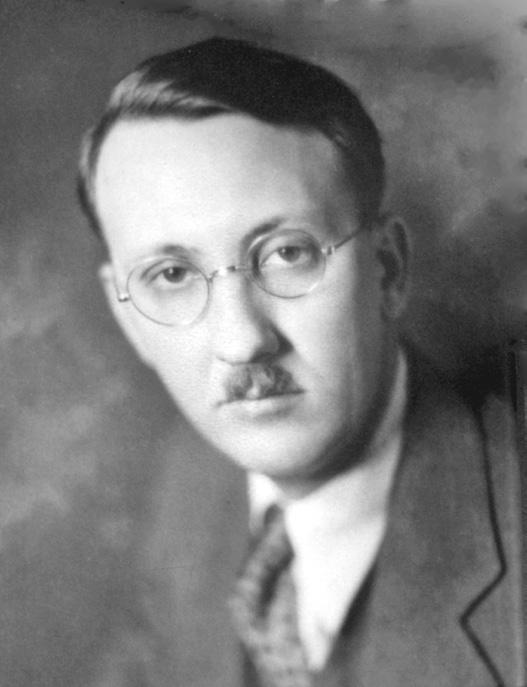
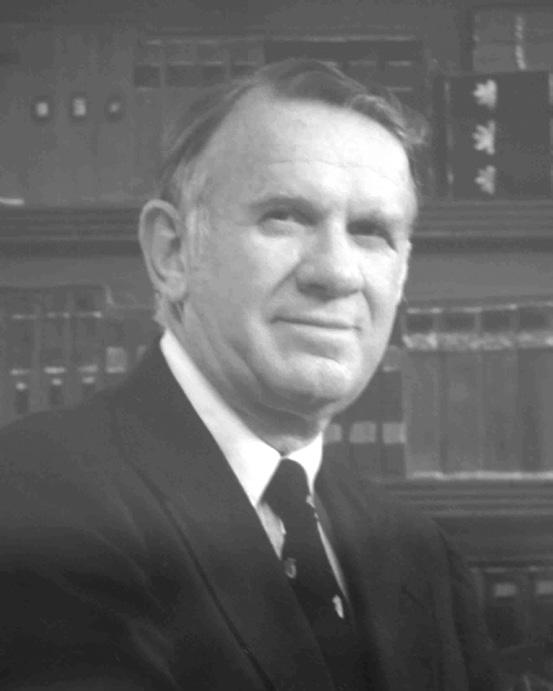
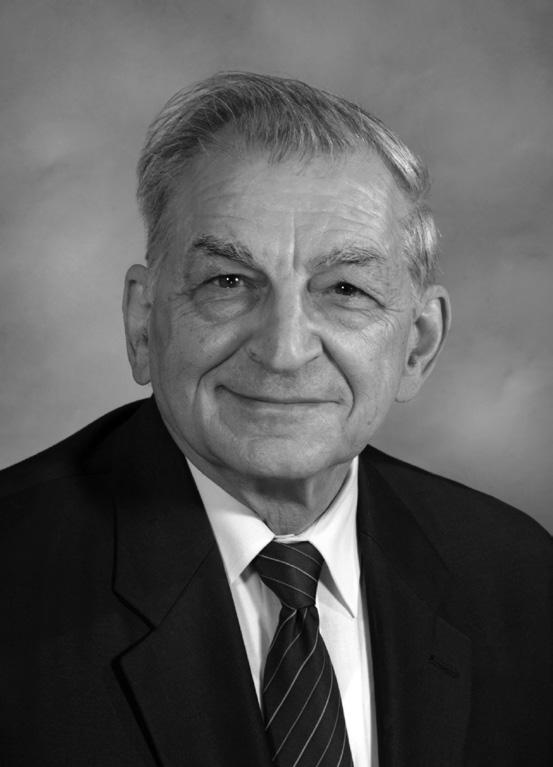
American Board of Plastic Surgery was formed in 1941, Dr. Young received his certification in accordance with a grandfather clause.
In September 1950, Dr. Robert M. McCormack, who completed his residency in plastic surgery under Dr. Young, was recruited from his practice in Milwaukee, Wisconsin to succeed Dr. Young, who moved to California.
Residency rotations with plastic surgeons at The Genesee Hospital, Rochester General Hospital, and at Roswell Park Memorial Institute in Buffalo with Dr. Vahram Bakamjian, were established. In 1959, Dr. Lester M. Cramer joined the faculty and initiated a program, in conjunction with the Eastman Dental Center, for the treatment of cleft lip and palate. Dr. Cramer left in 1966 to chair the Division of Plastic Surgery at Temple University Medical Center. In 1960, Dr. Harold Bales, trained in general and plastic surgery in Rochester, was added to the faculty, and continued as a valuable contributor until his untimely death in 1974. The void left by the loss of Drs. Cramer and Bales was filled by Dr. George P. Reading, who remained a member of the faculty from 1975 through 1995. In 1973, Dr. Elethea H. Caldwell, who also trained in the program, joined the faculty and continued to practice for over three decades.
In April 1962, the Division of Plastic Surgery hosted the first Plastic Surgery Residents Conference, which was patterned after the University Surgical Residents Conference. In 1975, a combined post-residency fellowship in hand surgery was established in concert with the Department of Orthopaedic Surgery. Dr. McCormack, as noted in the section entitled “Those Who Have Passed Through,” held an almost unmatched number of national leadership roles in the areas of his interests.
In January 1994, Dr. McCormack, who served as chair of plastic surgery for 33 years, was replaced by Dr. R. Christie Wray, formerly of Barnes Hospital in St. Louis. The Roswell Park rotation was eliminated when Dr. Wray assumed the chair, and the time was assigned to The Genesee Hospital where Dr. Vincent
F. Reale was chief of plastic surgery, and Rochester General Hospital, under the direction of Dr. H. Raul Herrera. A coordinated residency program was initiated, in which the R1 through R3 years were spent in general surgery, and the R4 and R5 years were exclusively committed to plastic surgery. Dr. Joseph Serletti joined the faculty in 1990 after completing a fellowship in reconstructive microsurgery. In September 1998, Dr. Serletti assumed the chair of plastic surgery when Dr. Wray left for the University of Georgia. Dr. Vincent Reale moved to Strong Memorial Hospital as a member of the full-time faculty, and he was joined by Dr. Andrew Smith, Dr. John Girotto, Dr. Karl Michalko, and Dr. Stephen Vega. Dr. Serletti left to become chair of plastic surgery at the University of Pennsylvania in 2005, and Dr. Howard N. Langstein, from the M.D. Anderson Hospital in Houston, was appointed chair in September 2005.
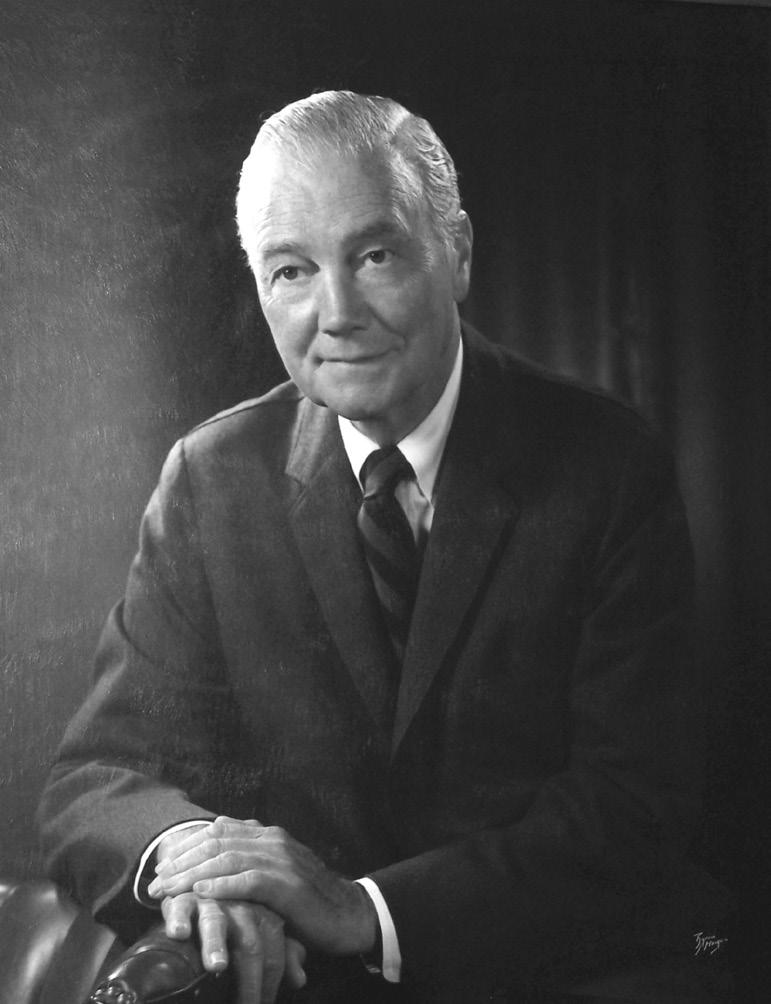
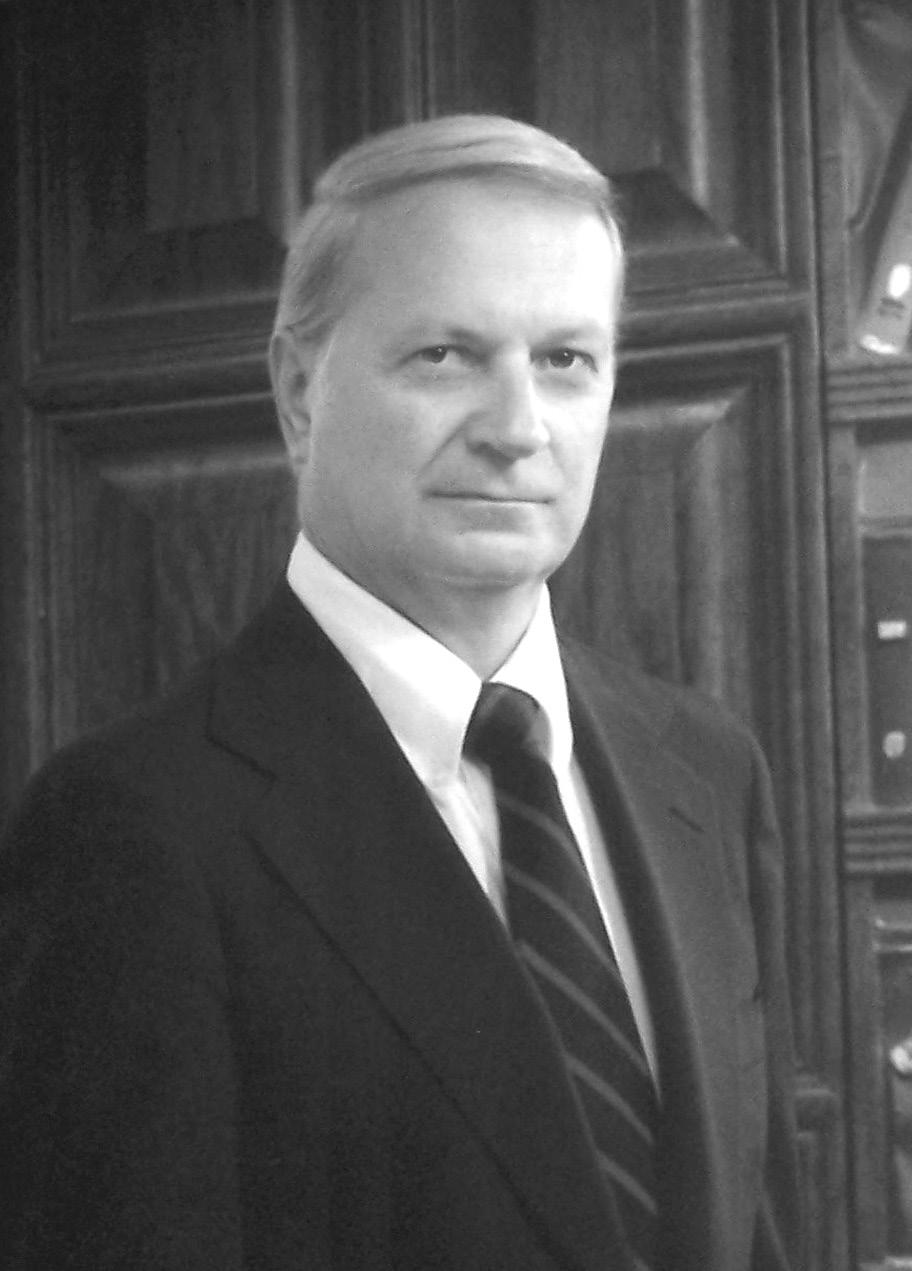
In 1947, Dr. George L. Emerson returned to Rochester, after a year fellowship at Yale Medical Center, to begin the first practice committed to thoracic surgery. A Board of Thoracic Surgery was established nationally as an affiliate of the American Board of Surgery in 1948. About that time, Dr. Earle B. Mahoney began his leadership role in cardiac surgery at the University of Rochester Medical Center. Upon completion of his residency, Dr. DeWeese joined Dr. Mahoney in efforts to expand the university’s presence in the field. In 1969, a one-year program in cardiothoracic surgery was made available only to those who completed the general surgical residency. Two years later, an independent American Board of Thoracic Surgery was established. In 1975, the Division of Cardiothoracic Surgery with Dr. DeWeese as its chair was recognized within the department. A two-year training program was initiated in 1979.
Dr. George L. Hicks succeeded Dr. DeWeese as chair of the division in 1991. He concentrated his efforts on adult cardiac surgery, while Dr. Scott Stewart, who had joined the faculty in 1973, and, subsequently, Dr. George L. Alfieris focused on pediatric cardiac surgery. Over the course of time, Dr. Hicks was joined by Dr. William H. Risher, Dr. John M. Snider, and Dr. Lucian A. Durham III, who remained for variable periods. At this time, Dr. Peter A. Knight and Dr. Todd Massey, who initiated a successful cardiac transplantation program, participate with Dr. Hicks in the cardiac surgery program.
Dr. Clay E. Phillips was an active participant in non-cardiac thoracic surgery from 1964 until his retirement in 1994. In 1987, Dr. Richard L. Feins returned to the university to devote himself to non-cardiac thoracic surgery. He was joined by Dr. David Johnstone in 1993 and Dr. Thomas Watson in 1996. In 2004, Dr. Jeffrey Peters established the division of foregut surgery, incorporating non-cardiac thoracic surgery.
The department has always represented a center of excellence for vascular surgery. Drs. John Jamison Morton, Jr., W.J. Merle Scott, and Herman Pearse, early faculty in vascular surgery, were founding members of the Society of Vascular Surgery when it was formed in 1947. In the 1950s, vascular procedures were performed by Drs. Scott, Mahoney, Dale, DeWeese, and Schwartz. The department’s stature in the field was significantly increased by the presence of Dr. Charles Rob, who became chair of the Department of Surgery in 1961. A vascular surgery fellowship program was established in 1984 under the leadership of Dr. DeWeese, who was succeeded by Dr. Richard Green in 1991. Drs. John Ricotta, Kenneth Ouriel, Patrick Riggs, Cynthia Shortell, Karl Illig, Mark Davies, Jeffrey Rhodes, and Michael J. Singh have been members of the faculty.
Vascular surgery was granted divisional status in 1997. In 2005, Dr. Karl Illig as-

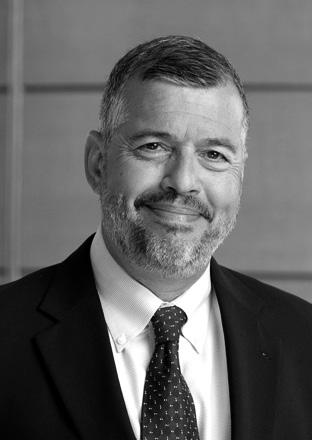
sumed the divisional chair. The stature of vascular surgery at the Medical Center is evidenced by the number of national and international leadership positions held by the faculty, and the number of graduates who have gone on to head programs at other institutions, as detailed in “Those Who Have Passed Through.”
Dr. John H. Morton was designated by Dr. Rob as the coordinator of trauma surgery in 1961. Dr. Morton also supervised the management of burns with Dr. Robert McCormack, and, for 16 years, Morton was in charge of Strong Memorial Hospital’s emergency room. In 1989, Dr. David V. Feliciano was recruited to supervise trauma care. When he left in 1994 to become chief of surgery at the Grady Hospital in Atlanta, Dr. Palmer Q. Bessey assumed that role until his departure in 2000. Dr. Erik S. Barquist assisted in the management of trauma and critical care from 1996-1999. The management of trauma was expanded significantly with the recruitment of Dr. Paul Bankey in 2000. The trauma faculty increased with the additions of Drs. Julius D. Cheng, Mark L. Gestring, Nicole A. Stassen, and Christopher W. Lentz as director of the burn center. The trauma division’s responsibility was expanded to incorporate emergency surgery.
The pediatric surgical needs of the community were met by Dr. Robert R. White from 1959 through 1979 prior to the recruitment of Dr. Walter Pegoli in 1997. Dr. White trained with Dr. Robert Gross at the Boston Children’s Hospital and, while in Rochester, produced the first atlas of pediatric surgical procedures. He was joined in his community practice by Dr. Thomas C. Putnam and Dr. Robert W. Emmens. Dr. Pegoli was appointed chief in 1997, and he was joined by Drs. Drugas and Santos.
(established 2003)
Dr. Allyn May, in general surgery, and Dr. Charles Linke, in urology, initiated the renal transplantation program. Dr. James C. Cerilli joined the faculty as director of transplantation in 1989, followed shortly thereafter by Drs. Michael Morris, Mark Orloff, and Louis Mieles. With the retirement of Dr. Cerilli in 1994, Dr. Oscar L. Bronsther assumed leadership and developed programs in hepatic and pancreatic transplantation. Dr. Bronsther left in 2000, and Dr. Amadeo Marcos assumed his role. During the brief two years of Dr. Marcos’s tenure, the hepatic transplantation program became one of the busiest in the United States. Dr. Marcos then became director of the transplantation service at the University of Pittsburgh, and Dr. Adel Bozorgzadeh was named chair of the division. He recruited Drs. Ashok K. Jain and Peter Abt.

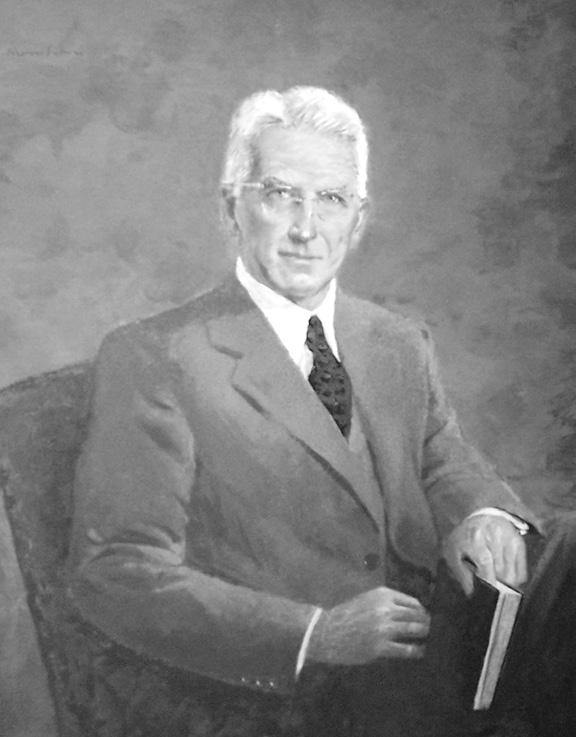
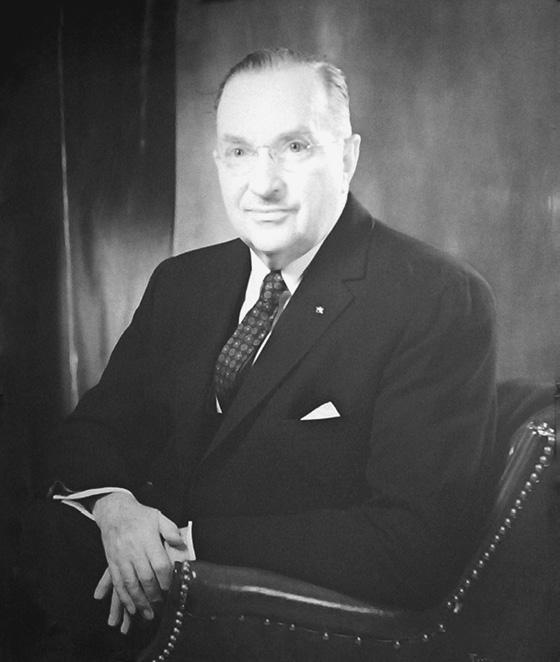
At its inception, the Department of Surgery, in addition to the current divisions, included other specialty divisions: anesthesiology, orthopaedic surgery, ophthalmology, urology, neurosurgery, and otolaryngology, which were integral elements that achieved departmental status over the years. This history considers these specialties and their participants before they were granted departmental autonomy.
Nurse anesthetists administered anesthesia until 1953, prior to the arrival of Dr. Robert Sweet, the first chief of the division of anesthesia. He remained for one year before moving to the University of Michigan as chair the Department of Anesthesiology. Dr. Sweet was replaced by Dr. Nicholas Greene, who similarly stayed for a year and left to chair a department of anesthesiology at Yale University. Dr. Vernon Thomas chaired the division from 1954 through 1959, followed by Dr. Alistair Gillies. Anesthesiology was granted departmental status in 1969.
Dr. R. Plato Schwartz chaired the division of orthopaedics from 1926 through 1957. He established one of the first gait laboratories. Dr. Robert Robinson, who would later become the chair of the Department of Orthopaedics at Johns Hopkins, and Dr. Frederick Zuck joined the division, while a significant proportion of the clinical practice was carried out by community based orthopaedic surgeons. Dr. Robert B. Duthie arrived from the United Kingdom to assume the chairmanship of the division in 1958. He left in 1966 to become the Trueta Professor and later the Nuffield Professor or Orthopaedic Surgery at Oxford University. In 1969, Dr. Louis A. Goldstein, an international authority on scoliosis, was recruited from his clinical practice in Rochester and served as divisional chair until 1974. That year marked the establishment of the Department of Orthopaedic Surgery under the leadership of C. McCollister Evarts, a graduate of the Rochester Medical School and the residency program, who had been chair of orthopaedic surgery at the Cleveland Clinic.
Ophthalmology began as a division of surgery in 1927, and was initially headed by Dr. Albert C. Snell, who was in practice in the city. In 1931, Dr. John Gipner, another established community ophthalmologist, assumed the leadership position that he held until 1961 when he was replaced by Dr. Albert C. Snell, Jr. Dr. Snell continued to coordinate the residency program until 1978. Ophthalmology attained departmental status with the advent of Dr. Henry Metz as chair in 1978.
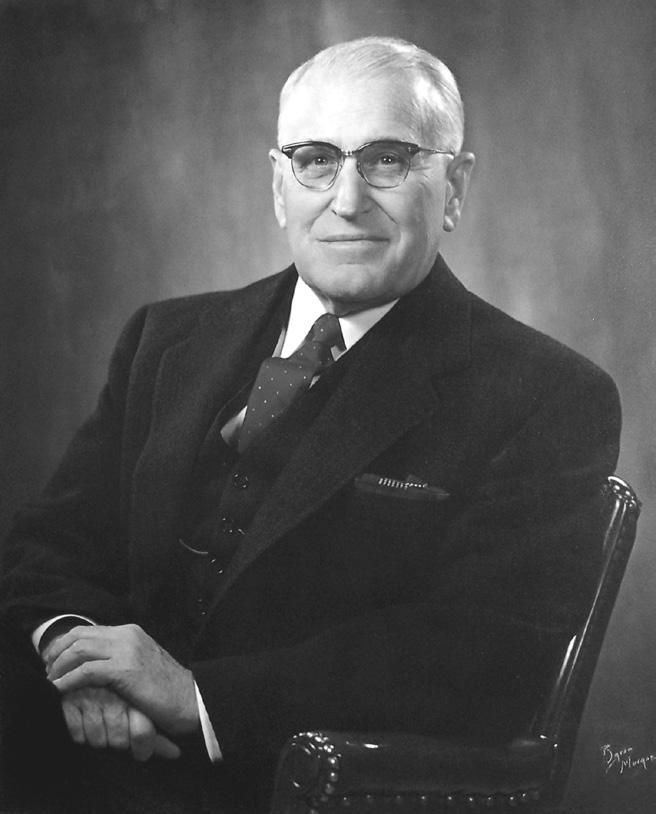
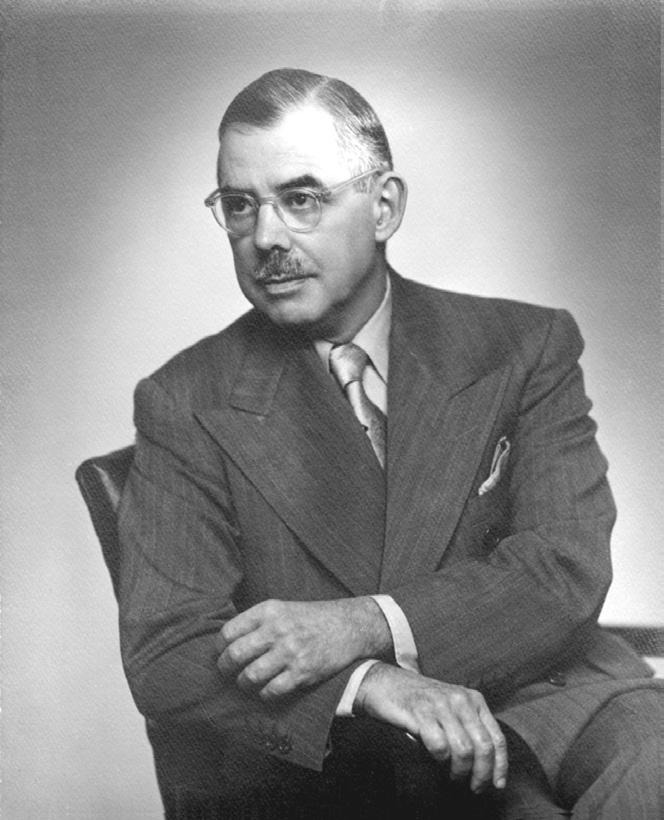
The history of urology within the Department of Surgery began, in 1926, with the appointment of Dr. David M. Davis from Johns Hopkins Medical School as the first chair. Two years later, Dr. Winfield W. Scott, another trainee of Dr. Hugh Young at Johns Hopkins, replaced Dr. Davis and directed the division for 30 years. Dr. Scott established the residency that produced several chairs of academic programs. Associated with Dr. Scott on the faculty were Drs. Lawrence J. Parlow, Hobart L. Boyd, John A. Benjamin, and Irwin N. Frank.
Dr. Scott was responsible for the acquisition of a significant endowment for the division, the Buswell Fund. In 1958, Dr. Donald F. McDonald succeeded Dr. Scott and coordinated studies of renovascular hypertension and the endocrine management of cancer of the prostate. Dr. McDonald stepped down in 1967, and Dr. Frank served as interim chair until Dr. Abraham T.K. Cockett arrived.
Dr. Frank recruited Dr. Charles Linke, who initiated a renal transplantation unit with the cooperation of Dr. Allyn G. May. Four years after Dr. Cockett was appointed chair of the division of urology in 1969, it became an independent department.
Dr. John J. Morton, Jr. performed neurosurgical procedures at the onset. In 1928, Dr. William P. Van Wagenen joined the surgical staff, as an instructor in Surgery, with the charge to specialize in neurosurgery. He trained under Dr. Harvey Cushing, and he also served as a resident at Memorial Hospital in New York City and Rochester General Hospital. In 1930, Dr. VanWagenen was listed in the medical school catalogue as assistant professor of neurosurgery, the first mention of the specialty in print. The next year, Dr. VanWagenen received a gift to establish the Abner Perry Fund to support a research fellow in neurosurgery. This was the first endowed fund within the department.
Dr. VanWagenen helped organize the Harvey Cushing Society, which evolved into the American Association of Neurological Surgeons, and was elected its first president in 1931. The American College of Surgeons designated the University Rochester neurosurgery program as one of 18 within the United States approved for training in 1939. During World War II, while Dr. VanWagenen was in the Army, Dr. Jack French supervised the service, and the residency was curtailed until 1946 when the faculty returned. After training under Dr. VanWagenen and spending a fellowship year at the University of California, Dr. Frank P. Smith joined the faculty in 1949. In 1954, Dr. VanWagenen retired, and a division of neurosurgery was established. Dr. Smith was appointed chief of the division in 1956 and, shortly thereafter, Dr. Joseph V. McDonald joined the faculty. Following a hiatus of several years, the residency was re-established.
Dr. McDonald was appointed chair of the Division of Neurosurgery in 1975. In 1980, Dr. and Mrs. Frank P. Smith endowed a chair in neurological surgery,
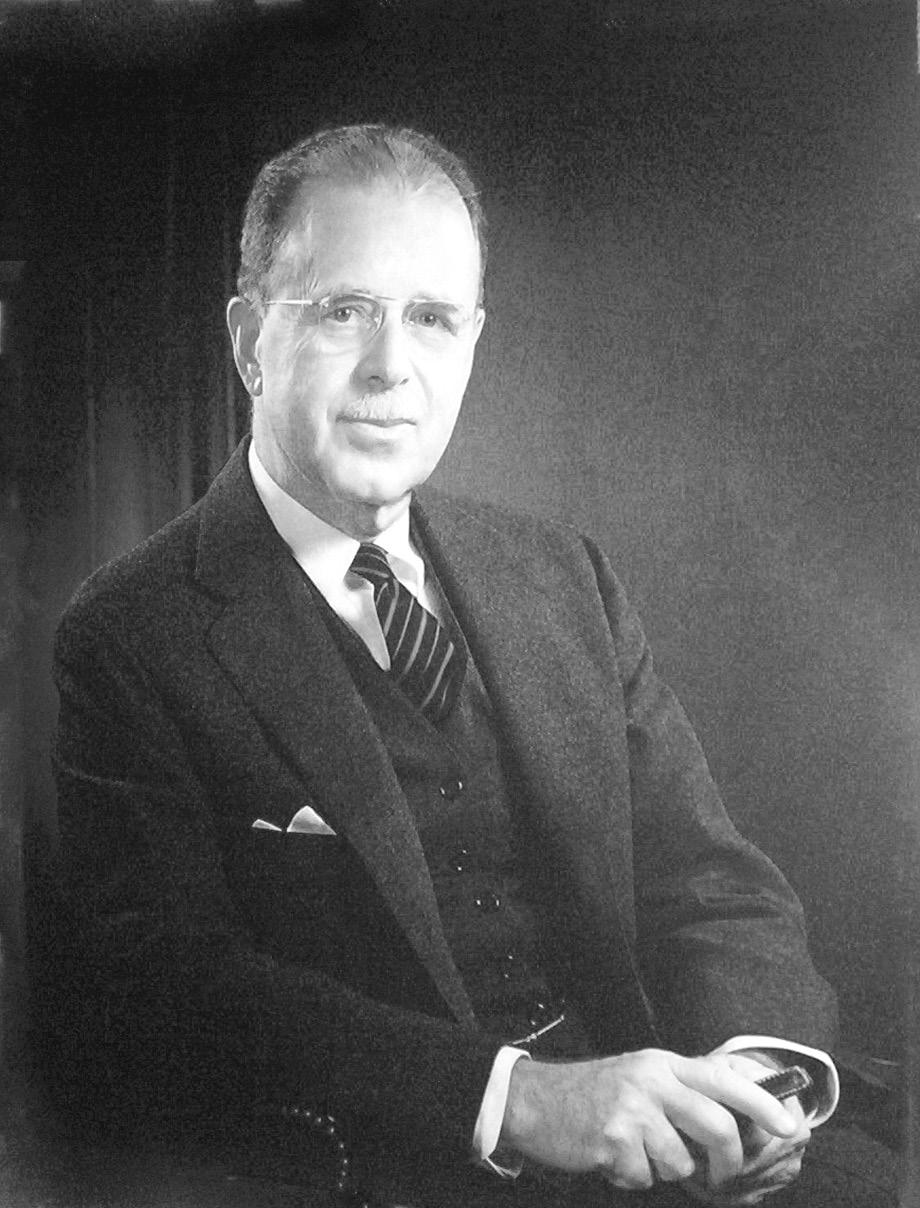
the first endowed chair within the Department of Surgery. Dr. Shige Okawara returned to Strong Memorial Hospital after a brief stay at the University of Iowa as an associate professor. Dr. Curtis Nelson later joined the faculty and Dr. Thomas Rodenhouse, who had a community practice, participated part-time. Dr. Webster Pilcher, who trained in Rochester, joined the faculty in 1990 after a fellowship in epilepsy surgery. Dr. Eugene George, who had served as chair of neurosurgery at Walter Reed Hospital, was appointed chair of the division in 1991. He left to assume a position at the University of Texas in 1993. In 1992, Dr. Paul Maurer, another product of the Rochester training program, returned as an assistant professor. Neurosurgery became an independent department within the medical school in 1998, and Dr. Robert J. Macunias was recruited as chair.
The presence of the specialty at the medical center was initiated with the appointment of Dr. Clyde Heatly as the “chief of service.” Dr. Heatly completed his residency at Johns Hopkins Hospital and, subsequently, received a Rockefeller fellowship that allowed him to visit outstanding clinics in Vienna, Zurich, and Edinburgh. He also studied endoscopy with Dr. Chevalier Jackson, a pioneer in the field. Upon Dr. Heatly’s arrival in 1928, he received neither a salary nor space within the medical center and, consequently, established an office in the city. Aided by Dr. Stuart Nash, a residency program developed and the first graduate, Dr. George Hillman, who remained in the community, later gained expertise in microsurgery of the ear for otosclerotic deafness and participated in training the residents. Among the residents trained, Dr. Ben Emerson and Dr. Gertrude Bales, the first geographic-full time member of the otolaryngology faculty, confined their practices to Strong Memorial Hospital.
Dr. John P. Frazer was appointed chair of the division in 1962. A native Rochesterian and graduate of the University of Rochester Medical School, Dr. Frazer, the first full-time chair of otolaryngology, trained at Yale and was a respected otologist in Honolulu. Members of the Rochester Otolaryngology Group, a large community-based practice, participated in the training program. Dr. John Norante, a graduate of the residency, joined the faculty in 1971 after a fellowship in head and neck surgery. Dr. James Toomey was also recruited to the division and remained four years before accepting a position as chief of otolaryngology at the University of Connecticut. During Dr. Frazer’s tenure, the residency expanded from 3 to 6 trainees.
In January 1981, Dr. Arthur S. Hengerer, a specialist in pediatric otolaryngology practicing in Rochester, assumed the divisional chair. Shortly thereafter, Dr. Charles C. Parkins was recruited to develop a research program, and he brought the first National Institutes of Health grant, a study of cochlear function, to the division. Dr. Paul Dutcher, a former resident who subsequently took specialty training in neurotology, joined the faculty. Dr. Vito Quatela, a University of Rochester undergraduate was recruited to provide expertise in facial plastic
and reconstructive surgery. The residency program changed from 2 years general surgery followed by 3 years of otolaryngology to 1 and 4 years respectively. The number of residents was increased to 8 with 2 at each level.
In 1989, Robert Frisina, PhD was appointed director of otolaryngology research. Dr. Frisina’s father, the former president of the National Technical Institute for the Deaf at the Rochester Institute of Technology (RIT), was instrumental in establishing a joint venture between RIT and the University of Rochester. This resulted in the establishment of the Rochester International Center for Hearing and Speech Research (RICHS). In 1994, a grant was received to study hearing loss in the aging, and, over the ensuing years, about 14 million dollars were infused into this research project.
In 1989, Dr. John Wayman, a graduate of the residency, joined the faculty and the following year Dr John Coniglio, another graduate of the program with specialty training in head and neck surgery, also joined the faculty. When he and Dr. Quatela left for community practice, they were replaced by Dr. Saurin Popat and Dr. Timothy Doerr. Dr. Ronald Pulli, who confined his practice to Parkridge Hospital, became a full-time faculty member. In 2003, Dr. Kenneth Whittemore, a graduate of the University of Rochester Medical School, was recruited for his interest in pediatric otolaryngology. Dr. C. Michael Haben, and Drs. James S. Hadley and Chase Miller, both graduates of the residency and specialists in allergy otolaryngology, also joined the faculty. Otolaryngology was granted departmental status in 2004.
On the occasion of the Department of Surgery’s 25th anniversary in 1950, Dr. John Jamison Morton, Jr. wrote “ A department of surgery in any medical school exists because of several functions, which it performs. In the first place, it must provide teaching of fundamental surgical principles to undergraduate and graduate medical students. Secondly, it should aim to produce well-rounded general practitioners and well-qualified general and specialized surgeons. Thirdly, it should give the best possible surgical service to the citizens of its community and environs. Fourthly, it should train men to improve upon the practice of surgery by seeking and applying basic discoveries made in experimental laboratories. Fifthly, it should provide opportunity for the development of future teachers of surgery. What the exact order of importance for these various endeavors remains debatable.”
Dr. Morton’s credo has served as a beacon directing the course of the department for eight decades. The products of the past provide a source of pride. It is anticipated that the future will be characterized by a continual expansion of that pride.
The individuals listed below include those who graduated from the baccalaureate program of the University of Rochester [U], graduates of the University of Rochester School of Medicine and Dentistry [M], those who spent part of their residency in the Department of Surgery [r], those who completed their residency in surgery in general surgery or in a surgical specialty while the specialty was incorporated in the Department of Surgery [R], Fellows [Fe], and faculty [F].
Chief Executive Officers of Academic Medical Centers
Cosgrove, Delos M. III [r] Cleveland Clinic
Evarts, C. McCollister [M, R, F] Hershey Medical Center (Penn State),
University of Rochester Medical Center
Plume, Stephen K. [M, R] Mary Hitchcock Medical Center (Dartmouth)
Skinner, David B. [U] Cornell University Medical Center
Deans
Adesola, Akin O. University of Kaduna,Nigeria Evarts, C. McCollister [M, R, F] Hershey Medical Center (Penn State) Iguina-Reyes, Jose [R] University of Ponce, Puerto Rico Parry, William L. [M, R, F] University of Oklahoma
Chairs of Departments of Surgery
Buxton, Robert W. [R] University of Maryland Condon, Robert E. [M] University of Iowa, Medical College of Wisconsin Dempsey, Daniel T. [M] Temple University Medical Center Eklof, Bo [Fe] University of Kuwait Elebute, E. Ade [Fe] University of Lagos, Nigeria Green Richard [M, R, F] Lenox Hill Hospital
New York City Jaffe, Bernard M. [U] Downstate Medical Center (Brooklyn)
Jamieson, Glen G. [Fe] University of Adelaide, Australia Maloney, James V. [U] University of California, Los Angeles Masters, Francis W. [r] University of Kansas Moretz, William H. [R] Medical College of Georgia Ouriel, Kenneth [R, Fe, F] Cleveland Clinic
Parker, Frederick B., Jr. [M] State University of New York Health Sciences
Center, Syracuse Payne, Douglas, D. [R, Fe] Tufts University Medical Center
Pories, Walter J. [M, R, F] Eastern Carolina School of Medicine Ricotta, John [F] Stoney Brook Medical Center Sawyers, John L. [U] Vanderbilt Medical Center Schilling, John A. [F] University of Oklahoma, University of Washington
Schwartz, Seymour I. [R, F] University of Rochester Medical Center Skinner, David B. [U] University of Chicago Medical Center Whalen, Thomas J. [R]
University of Hawaii
Chairs of Surgical Specialty Departments Anesthesiology
Sweet, Richard [F] Chair, Department of Anesthesiology, University of Michigan Medical Center
Greene, Nicholas M. [F] Chair, Department of Anesthesiology, Yale University Medical Center
Gillies, Allistair [F] Chair, Department of Anesthesiology, University of Rochester Medical Center
Orthopaedics
Bliven, Theodore [R, F] Medical College of Georgia Burton, Richard I. [R, F] University of Rochester Medical Center Evarts, C. McCollister [M, R, F] Cleveland Clinic, University of Rochester
Medical Center Glimcher, Melvin [r] Massachusetts General Hospital, Harvard University Goldstein, Louis [R, F] University of Rochester Medical Center Hoagland, Frank [R] University of Vermont Medical Center Iguina-Reyes, Jose [R] University of Ponce, Puerto Rico Robinson, Robert [F] Johns Hopkins Medical Center Rosier, Randy [M, R, F] University of Rochester Medical Center
Urology
Andriole, Gerald L. Jr. [R] Washington University Medical Center Caldamone, Anthony A. [R] Brown University Medical Center Miller, Harry C. [R, F] George Washington University Medical Center Nakada, Stephen Y. [R] University of Wisconsin Medical Center Parry, William L. [M, R, F] University of Oklahoma Medical Center Radwin, Howard M. [r] University of Texas, San Antonio Medical Center Retik, Alan B. [r] Boston Children’s Hospital, Harvard University Schlegel, Jorgen U. [R, F] Tulane University Medical Center Young, John [R, F] University of Maryland
Neurolgical Surgery
French, J. Douglas [R, F] University of California Medical Center, Los Angeles Grossman, Robert G. [r] Baylor University Medical Center McDonald, Joseph V. [F] University of Rochester Medical Center Pilcher, Webster H. [M, R, F] University of Rochester Medical Center Raaf, John E. [r] University of Oregon Medical Center Smith, Frank P. [M, R, F] University of Rochester Medical Center
Otolaryngology
Sherris, David A. [M, R] University of Buffalo Medical Center Toomey, James [F] University of Connecticut Medical Center Yarrington, Thomas [R] University of Nebraska Medical Center
Plastic Surgery
Cramer, Lester M. [F] Temple University Medical Center McCormack, Robert M. [R] University of Rochester Medical Center Rockwell, H. Bradford [R] University of Utah Serletti, Joseph [M, R, F] University of Pennsylvania Vasconez, Louis [R] University of California, San Francisco,
Wray, R. Christie [F] University of Rochester Medical Center, Medical College of Georgia Young, Forrest [R, F] University of Rochester Medical Center
Fung, John J. [R] Cleveland Clinic
Pediatric Surgery
Randolph, Judson G. [r] National Children’s Hospital, George Washington University
Weintraub, William H. [r] St. Christopher’s Children Hospital
Cardiothoracic Surgery
Berkley, Brandt [Fe] Syracuse University Medical Center Cosgrove, Delos M. III [r] Cleveland Clinic DeWeese, James A. [M, R, F] University of Rochester Medical Center Edwards, Niloo M. [R] University of Wisconsin Medical Center Hicks, George L. [M, R, Fe] University of Rochester Medical Center Magilligan, Donald, J. [R, Fe] Henry Ford Medical Center, University of California Medical Center, San Francisco Mijangos, Jose F. [R, Fe] Dartmouth Medical Center Olinger, Gordon N. [M] Medical College of Wisconsin Medical Center Payne, Douglas D. [R, Fe] Tufts Medical Center Salley, Robert K. [Fe] University of Kentucky Medical Center Smith, Craig R. [R] Columbia Presbyterian Medical Center
Feins, Richard L. [R, Fe, F] University of Rochester Medical Center Ginsberg, Mark E. [R, Fe] Columbia Presbyterian Medical Center Johnstone, David [F] Dartmouth Medical Center Putnam, Joe B. [R] Vanderbilt Medical Center Reed, Carolyn E. [M] University of South Carolina Medical Center
Blebea, John [Fe] Temple University Medical Center DeWeese, James A. [M, R, F] University of Rochester Medical Center Green, Richard [M, R, F] University of Rochester Medical Center Illig, Karl A. [R, Fe, F] University of Rochester Medical Center Logerfo, Frank [M] Beth Israel and Deaconess Hospitals, Harvard University
Nesbit, Robert [R] Medical College of Georgia Ouriel, Kenneth [R, Fe, F] Cleveland Clinic Shortell, Cynthia [R, Fe, F] Duke University Medical Center Towne, Jonathan B. [M] Medical College of Wisconsin
Presidency of Major Associations, Boards, Societies and Organizations
Burton, Richard I. [M, F]American Society for Surgery of the Hand Chan, Donald P. K. [F] Society for Surgery of the Spine Cockett, Abraham T. K. [F] Northeastern Section American Urological
Association, American Urological Association Condon, Robert E. [M] Central Surgical Association Cramer, Lester M. [F] American Society of Maxillofacial Surgeons Dale, W. Andrew [R, F] Society for Vascular Surgery, North American Chapter International Cardiovascular Society DeHaven, Kenneth [R, F] American Orthopaedic Association DeWeese, James A. [M, R, F] Society for Vascular Surgery, North
American Chapter International Cardiovascular Society, American Venous Forum, PanPacific Surgical Society
Eklof, Bo [Fe] American Venous Forum Evarts, C. McCollister [M, R, F] American Board of Orthopaedic Surgery, Hip Society, American Orthopaedic Association, American Association of Hospital Centers
Feins, Richard H. [R, Fe, F] American Board of Thoracic Surgery
Frank, Irwin N. [M, R, F] Northeastern Section American Urological Association, American Urological Association Goldstein, Louis A. [R, F] Scoliosis Research Society Green, Richard, [M, R, F] Eastern Vascular Society, Society for Vascular Surgery
Hadley, James S. [R, F] American Association of Otololaryngologic Allergy, American Rhinology Society Jaffe, Bernard M. [U] Society of University Surgeons Mahoney, Earle B. [M, R, F] Society for Vascular Surgery Maloney, James V. [M] Society of University Surgeons, American Surgical Association
McCormack, Robert M. [R, F] American Burn Association, American Society for Surgery of the Hand, American Board of Plastic Surgery, American Association of Plastic Surgeons Morton, John H. [R, F] New York State Medical Society
Peer, Richard [R] New York State Medical Society Pories, Walter J. [M, R, F] Society for Bariatric Surgery, Society of Surgical Program Directors
Randolph, Judson G. [r] American Pediatric Surgical Association
Reading, George [R, F] American Society of Plastic and Reconstructive Surgeons Ricotta, John [F] Eastern Vascular Society Rob, Charles [F] International Cardiovascular Society Sawyers, John L. [U] Southern Surgical Association Schwartz, Seymour I.[R, F] Central Surgical Association, Society for
Clinical Surgery, American Board of Surgery, American Surgical Association, American College of Surgeons Stabins, Samuel J. [R, F] Society of University Surgeons Towne, Jonathan B. [M] Society for Vascular Surgery Wray, R. Christie [F] American Association of Plastic Surgeons
Editorships
Pories, Walter J. Journal of Surgical Research
Schwartz, Seymour I. Yearbook of Surgery, Journal of American College of Surgeons, Principles of Surgery (7 Editions)
Joint Commission of Accreditation of Health Care Organizations
Frank, Irwin N. [M, R, F]
Institute of Medicine National Academy of Sciences
Evarts, C. McCollister [M, R, F] Schwartz, Seymour I. [R, F] Skinner, David B. [U]
American Philosophical Society
Schwartz, Seymour I. [R, F]
Seminal Contributions
Morton, John J.: The Organization of a Tumor Clinic in a General Hospital. Surgery, Gynecology and Obstetrics Vol. LII, 531-532, 1931. The first description of the incorporation of a multi-disciplinary tumor clinic in a general hospital in the United States.
Morton, John J.: Interinnomino-abdominal (Hindquarter) Amputation. Annals of Surgery Vol. 115, 628-646, 1942. A report of four cases. The first review of a series in the United States.
Pearse, Herman E., Radakovich, Michael and Cogbill, Charles L.: An Experimental Study of Antiperistaltic Jejunal Loops. Annals of Surgery Vol. 129, 57-64, 1949. The optimum length for the antiperistaltic limb of a Roux-Y type of anas-
tomosis was found to be 12 inches. An enteroenterostomy does not divert the entire intestinal stream even when the limbs of the loops are 24 inches in length.
Mahoney, Earle B. and Sherman, Charles D., Jr.: Total Esophagoplasty Using Intrathoracic Right Colon. Surgery Vol. 35, 937-946, 1954. A report of the first successful use of retrosternal replacement of the entire esophagus with the right colon in the United States and an extensive review of esophageal replacement.
Schwartz, Seymour I. and Dale, W. Andrew: Primary Sclerosing Cholangitis.
A. M. A. Archives of Surgery Vol. 77, 439-451, 1958. The first report of a series (six new cases) and a review of the 13 previously reported cases.
Schwartz, Seymour I., Bales, Harold W., Emerson, George L. and Mahoney, Earle B.: The Use of Intravenous Pituitrin in Treatment of Bleeding Esophageal Varices. Surgery Vol. 45, 72-80,1959. This first series (9 patients) to report the successful use of Surgical Pituitrin and Pitressin to control bleeding esophageal varices. Intraoperative studies demonstrated a rapid and significant reduction of portal venous pressure subsequent to the intravenous injection of the medication.
Adams, James T. and DeWeese, James A.: Partial Interruption of the Inferior Vena Cava with a New Plastic Clip. Surgery, Gynecology and Obstetrics Vol. 123, 1087-1088,1966. The introduction of a serrated clip to be applied externally to the inferior vena cava to prevent embolization while maintaining flow. This was widely applied prior to the advent of intracaval filters.
Pories, Walter J., Henzel, John H., Rob, Charles G. and Strain William H.: Acceleration of Healing with Zinc Sulfate. Annals of Surgery Vol. 165, 432-436, 1967. The paper demonstrated the involvement of zinc in wound healing and significant zinc deficiency in burn patients. Oral supplementation accelerated healing significantly.
Schwartz, Seymour I., Griffith, Lawrence S., Neistadt, Arnold and Hagfors, Nils: Carotid Sinus Nerve Stimulation in the Treatment of Essential Hypertension. American Journal of Surgery Vol. 114, 5-15, 1967. The first report of electrical stimulation of the baroreceptor nerve resulting in immediate and long-term, significant reduction of blood pressure in patients refractory to medication. The technique was recently rejuvenated. Dr. Karl Illig is directing a national trial.
DeWeese, James A. and Rob, Charles G.: Autogenous Venous Grafts Ten Years Later. Surgery Vol. 82, 775-784, 1977. The mortality rate at 5 years and 10 years was reported, as was the actual graft patency for survivors. This paper brought into focus the long-term prognosis after peripheral arterial reconstruction.
This publication was conceived and coordinated by Dr. Seymour I. Schwartz, who is responsible for the research, the narrative, and the format. Dr. James A. DeWeese contributed significantly to the general surgical material, the residency program history, and the sections on Cardiothoracic and Vascular Surgery. Drs. Robert M. McCormack and Elethea H. Caldwell provided the material on Plastic Surgery. Drs. C. McCollister Evarts and Richard I. Burton served as references for Orthopaedic Surgery. Dr. Irwin M. Frank contributed material on Urology. Dr. Joseph V. McDonald is responsible for material on Neurological Surgery. Drs. John P. Frazer and Arthur S. Hengerer provided material on Otolaryngology.
Images were selected from the archives of the Miner Library with the assistance of Christopher Hoolihan. Copyediting was conducted by Andrea Weinstein and Manizheh Eghbali.

In the fall of 2014, Dr. David C. Linehan began his tenure as Seymour I. Schwartz Professor and Chairman of Surgery and Co-director of Clinical Operations at Wilmot Cancer Institute, University of Rochester Medical Center. A highly regarded hepatobiliary and pancreatic surgeon, Dr. Linehan has been recognized, particularly, for research regarding the applicability of immunotherapy and genomic considerations to improve the surgical outcomes for pancreatic cancers. As Dr. Linehan has become the subject of his first five year instittional review, the growth in the number of faculty and the stature of the Department has been impressive.
The Golisano Children’s Hospital opened in 2015 and provided an added stimulus for the establishment of two endowed professorships, the Lobozzo Professor of Pediatric Surgery and the Tansukh, Sarla and Rejesh Ganatra Professorship of Pediatric Cardiac Surgery. In 2019, Dr. Marjorie Arca, MD was appointed chief of Pediatric Surgery.
Two additional endowed professorships, the Dr. Jude S. Sauer Family Distinguished Professor in Cardiac Surgery, and the Marjorie B. Morris Endowed Professorship in Cardiac Surgery were awarded to Dr. Sunil Prasad as chief of Cardiac Surgery and Peter Knight, MD respectively. Carol Jones, MD chairs the division of Thoracic and Foregut Surgery. Michael Stoner, MD was recruited to the chair of Vascular Surgery. Joseph Johnson, MD remains the chief of Surgery and Bariatric Surgery at Highland Hospital.
Mark Gestring, MD has recently been designated the chief of Acute Care Surgery. Both he and Paul Bankey, MD serve on the American College of Surgeons Committee on Trauma. Michael Rotondo, MD who serves as vice dean for Clinical Affairs was chair of surgery of the East Carolina Medical School, president of the Eastern Association for the Surgery of Trauma, president of the Halsted Society, president of the American Association for the Surgery of Trauma, and chair of the American College of Surgeons Committee on Trauma. Dr. Nicole Stassen, also, served as president of the Eastern Association for the Surgery of Trauma.
Kristin Skinner, MD continues to chair the Division of Surgical Oncology (breast and melanoma). Howard Langstein, MD is the chair of Plastic Surgery and vice chairman for Academic Affairs and Faculty Development. Luke Schoeniger, MD is the chair of Hepato-Pancreato-Biliary and Gastrointestinal (HPBGI) Surgery. Larissa Temple, MD has become the chair of Colorectal Surgery. Roberto Hernandez-Alejandro, MD has been recruited as chair of the division
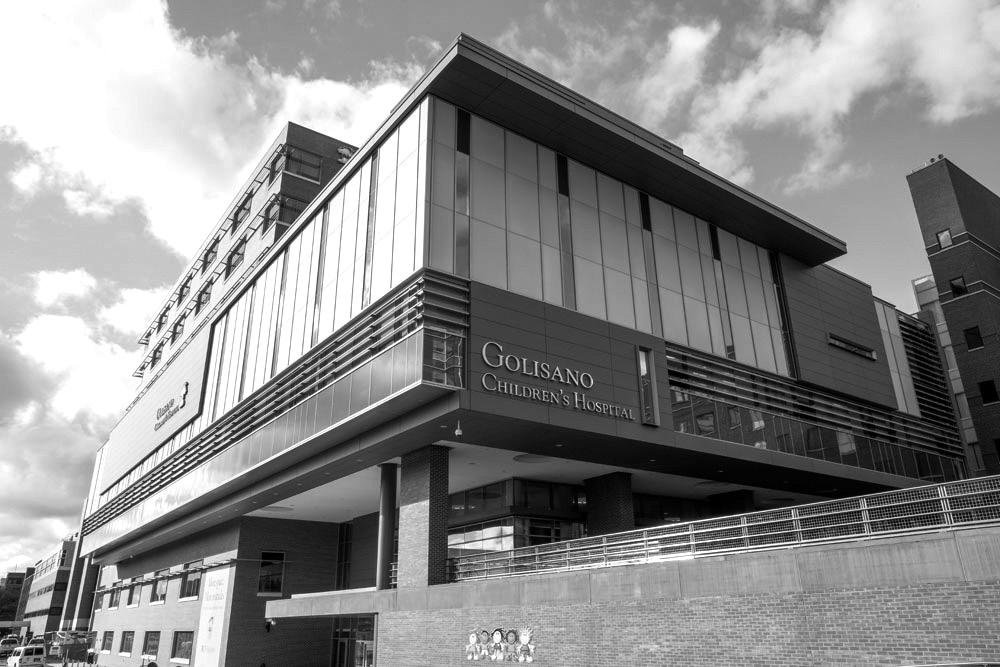
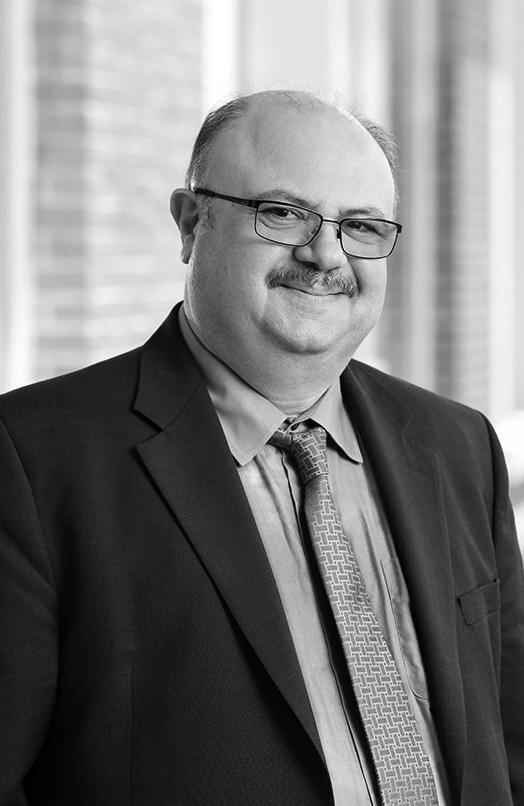
of Abdominal Transplantation and Liver Surgery, while Mark Orloff, MD has become the vice chair for Clinical Operations. Dr. Rabih Salloum is the Program Director of the Residency Program. ACGME presented Amy Mills with the GME Program Coordinator Excellence Award in 2019, one of five coordinators were recognized nationally.
The Department ranks 20th nationally among surgical departments for funded research, which includes large grants from the Cancer Control research group guided by Gary Morrow, PhD; the Surgical Health Outcomes Research Enterprise (SHORE) led by Larissa Temple, MD and Dr. Linehan’s lab, the Center of Tumor Immunology. The ACGME has accredited a one year fellowship on colorectal surgery. Since 2005, the Department of Surgery has hosted an annual symposium, including distinguished invited speakers to provide a forum for regional surgeons, primary care physicians and healthcare professionals to discuss the latest trends in the field.
“Collegiality” that has characterized the Residency Program and the interpersonal relations at all levels remains evident. The leadership roles that participants in the program have continued to assume remain a source of departmental pride.
Past residents or faculty who have become new chairs of Departments of Surgery:
• Stephen Johnson, MD (1993) has become the chair of the Department of Surgery at the University of Arizona College of Medicine, Phoenix.
• Mary T. Killackey, MD (2003) has become the chair of Surgery at Tulane University.
• Craig R. Smith, MD (1982) has become chair, Department of Surgery; Surgeon-in-Chief, NewYork-Presbyterian Hospital/Columbia University Medical Center.
• Thomas J. Watson, MD, FACS has become chair of Surgery, Georgetown University School of Medicine.
Past residents in the program who have become new divisional chiefs:
• Paul D. Danielson, MD (1999) has become the chief of Pediatric Surgery at Johns Hopkins All Children’s Hospital.
• Matthew J. Eagelton, MD (2000) has become the chief of Vascular Surgery at Massachusetts General Hospital.
• John Fung, MD, PhD (1988) has become chief of the Section of Transplantation Surgery and director of the New University
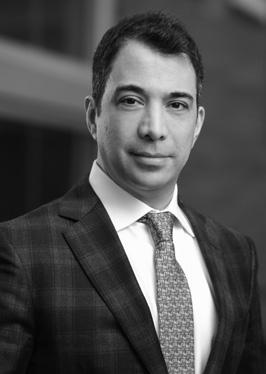
Roberto Hernandez-Alejandro, MD Abdominal and Liver Transplant
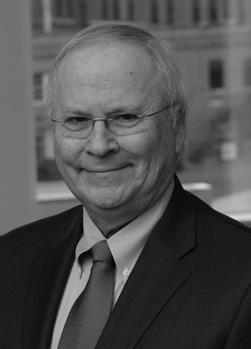
Gary R. Morrow, PhD Cancer Control
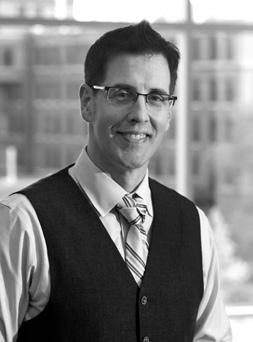
Brian Watkins, MD Regional

Howard N. Langstein, MD Plastic

Mark L. Gestring, MD Acute Care
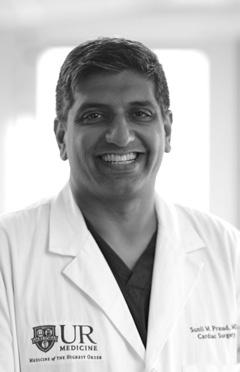
Sunil M. Prasad, MD Cardiac
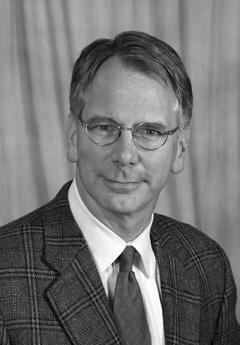
Luke O. Schoeniger, MD Hepato-Pancreato-Biliary and Gastrointestinal
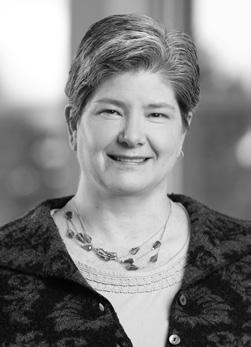
Kristin A. Skinner, MD Surg Onc
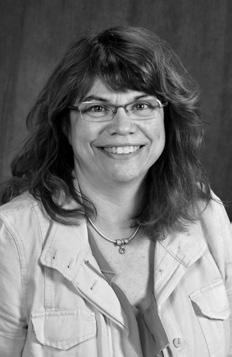
Carolyn E. Jones, MD Thoracic & Foregut
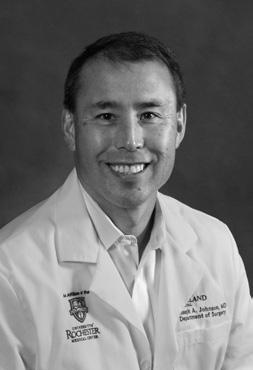
Joseph A. Johnson, MD Bariatric & GI
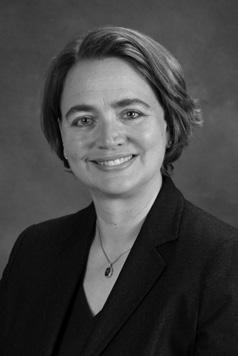
Larissa K.F. Temple, MD Colorectal
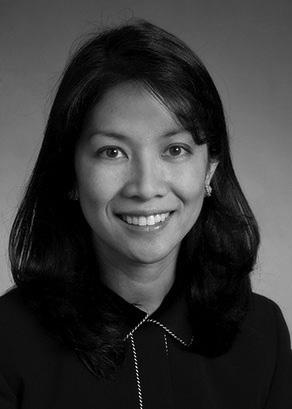
Marjorie J. Arca, MD Pediatric
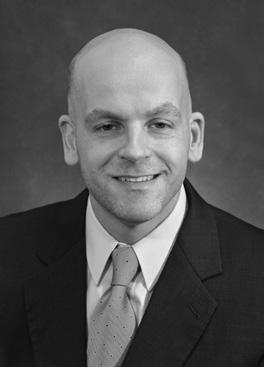
Micheal C. Stoner, MD Vascular
of Chicago Medicine Transplanatation Institute.
• Timur Sarac, MD (1997) has transferred to the Ohio State Medical Center and assumed the position of chief of the division of Vascular Surgery.
• Joseph M. Serletti, MD (1988) was the chair of The American Board of Plastic Surgery, Inc. from 2017-2018.
Other notable accomplishements include the following:
• Two of the four recently recognized “Icons of the American College of Surgeons are products of the URMC surgical residency, Walter J. Pories, MD (1967) and Seymour I. Schwartz, MD (1957).
• John B. Hanks, MD (1973) a graduate of the medical school had served as president of the Southern Surgical Association in 2018.
